#Mid-Late Tang Dynasty Period
Photo


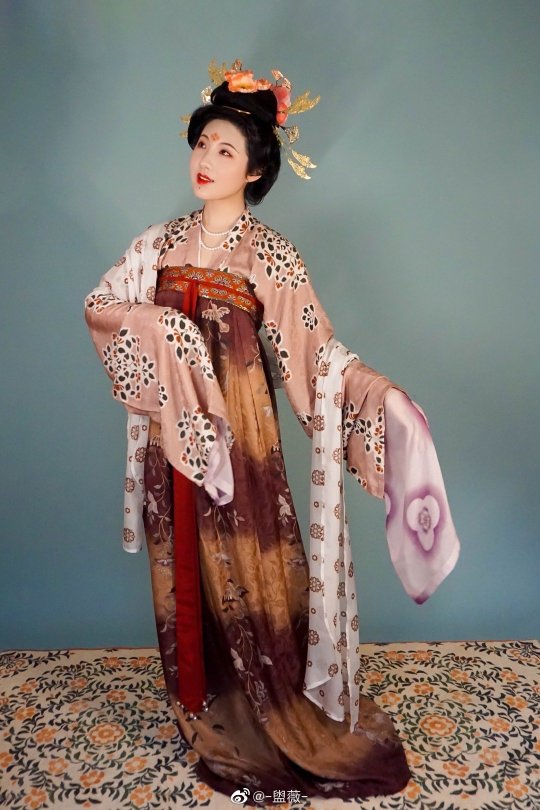






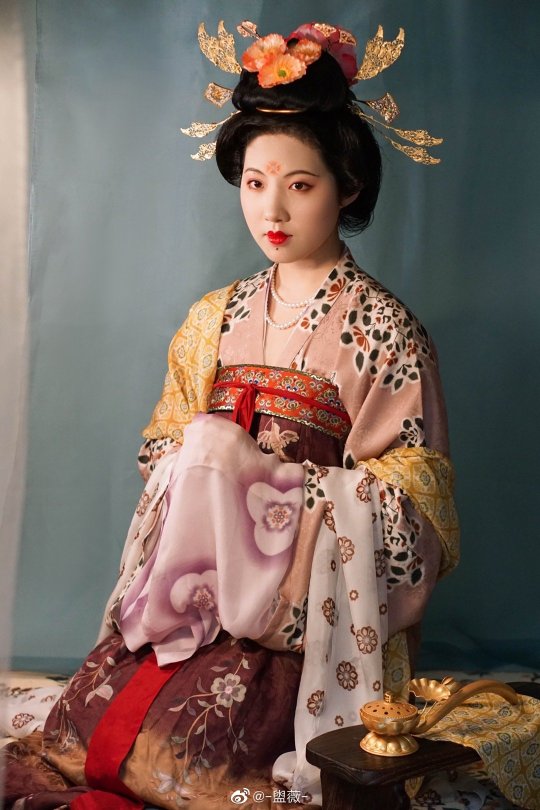
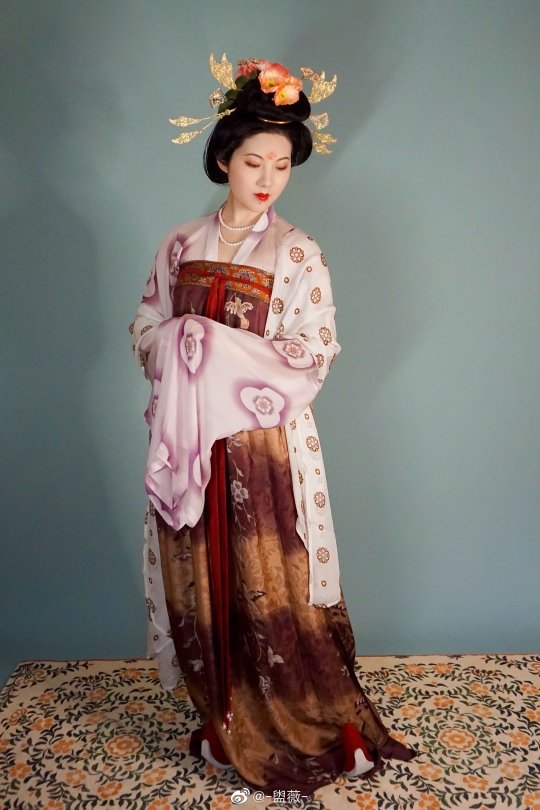

【Historical Artifacts Reference】
Skirt Pattern Reference:Tang Dynasty Murals<Mother and Daughter Doner>in Cave 12 of Dunhuang Mogao Grottoes.
※Due to the mural paint has long been oxidized, resulting in color differences※
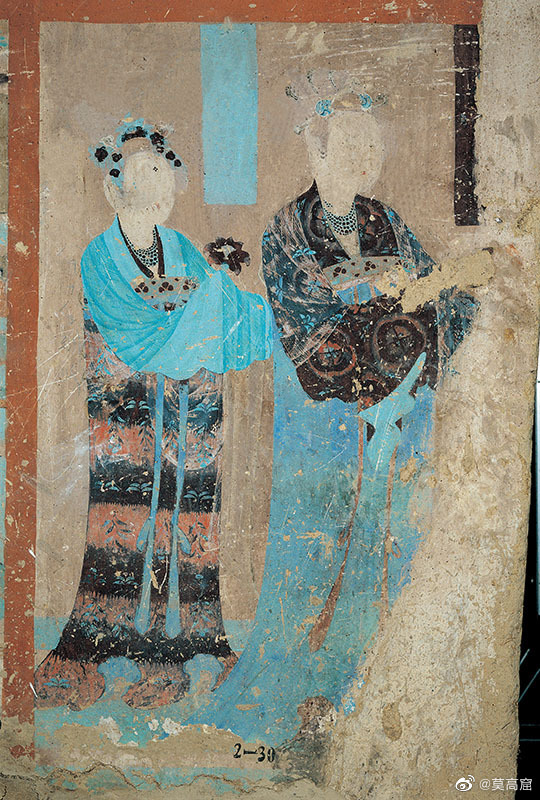
【Skirt Restoriation And Way Of Wearing Reference】
※Let the inner skirt show through the side※
China Five Dynasties and Ten Kingdoms Period:Murals From Tomb of Wang Chuzhi王處直(862–922)
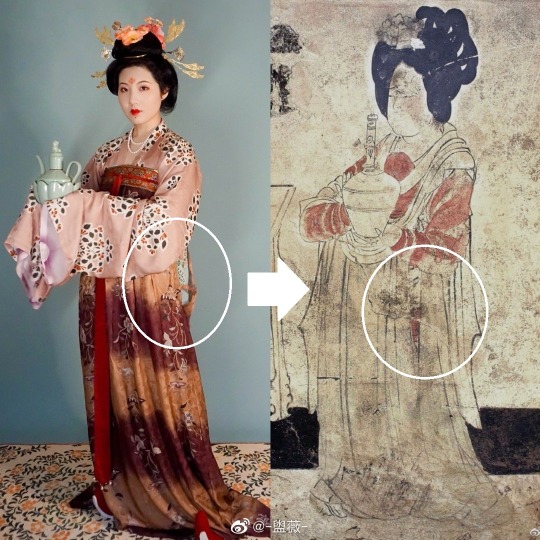
China Tang Dynasty Murals in Cave 159 of Dunhuang Mogao Grottoes.


【Tang Dynasty Hairpin Artifacts】


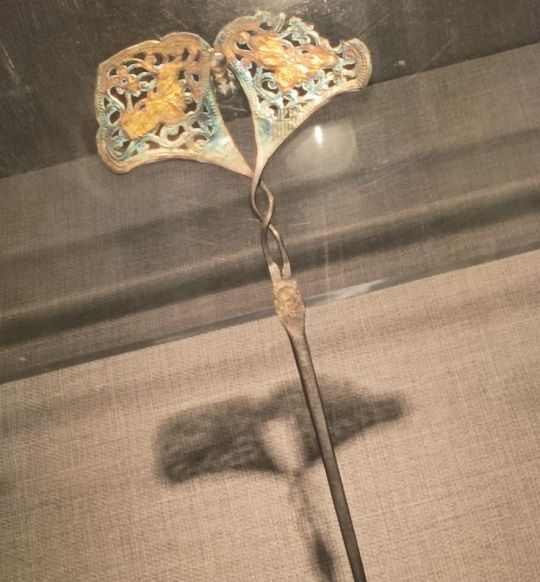


[Hanfu · 漢服]Chinese Tang Dynasty(618-907A.D)Traditional Clothing Refer to Tang Dynasty Dunhuang Mogao Grottoes Murals
Mid-Late Tang Dynasty Women's Attire
————————
📸Recreation Work:@-盥薇-
👗 Hanfu: @时合岁初传统服饰
🔗Weibo:https://weibo.com/3942003133/MC5n4viSt
————————
#Chinese Hanfu#Tang Dynasty(618-907A.D)#hanfu#chinese traditional clothing#chinese history#Mid-Late Tang Dynasty Period#hanfu history#chinese fashion history#ruqun#齊胸衫裙 qixiong shanqun#pibo 披帛#Chinese Culture#china#chinese#Huadian(花钿)#hanfu accessories#hanfu artifacts#Dunhuang Mogao Grottoes Cave#漢服#汉服#recreation#-盥薇-#时合岁初传统服饰#Tang Dynasty Hairpin Unearthed from the tomb of Wu King Wife Tomb#tang dynasty hairpin
230 notes
·
View notes
Note
do you know roughly what time period mount hua takes place? like if its during a specific dynasty or anything
most murim/wuxia take place in a very vague ancient time period that, unless the author specifically mentions what year it is, its impossible to tell.. as for rotmhs i dont think a specific year/dynasty has ever been mentioned so u pretty much have free range to put rotmhs in whichever dynasty feels right to you
ive seen some people speculate on time periods based on the type of hanfu characters wear but that hardly ever holds up seeing how in most wuxia media (mostly xianxia but i digress) that take place in this vague-wuxia-timeline, the robes are often mashed together into a conglomerate of a bunch of different dynastys styles, that or theyre purely fictional and only exist to be aesthetically pleasing and more xianxia-like..
purely my own headcanon though i like to imagine current timeline rotmhs takes place mid to late tang dynasty, chung myung having lived his life as geomjon some point in the early years of the sui dynasty and into the tang dynasty..or something.. *scratches ass* im still working on the math
#a lot of unnecessary information u didnt ask for my bad ive just seen people claim that some stories take place in THIS era or THAT era#even though they dont..based on zero concrete evidence..and that kind of ruffles my feathers for no reason at all..im so nit picky
7 notes
·
View notes
Text
“Night of the Fifteenth of the Eighth Month” (八月十五夜) Translation
(Another Mid-Autumn Festival, happy Mooncake Day to all! This post is a bit late but considering how swamped I am with work and life, it’s a miracle I remembered to post here lol....anyway please enjoy!)
Night of the Fifteenth of the Eighth Month (1)
By Yin Wengui (Tang dynasty, 9th century-early 10th century)
Cloudless clear heavens a mirror over the land (2),
Most perfect time for reunions (3) is Mid-Autumn.
Moonlight clinging to my garments a frosty iridescence,
And over the earth an aqueous brillance ready to flow.
Mountainous shadows in the distance chilly with dew,
Raging winds over yonder capping the waves with white.
Since you (4) illuminated my heart’s true thoughts,
The anxious man may have a carefree eve.
—————————-
Notes:
Mid-Autumn Festival falls on the fifteeth day of the eighth month in the lunar calender.
“The land” here is “九州” (Pinyin: jiu3 zhou1) in Chinese, which literally means “nine provinces”. This is a reference to the nine original provinces that were said to make up ancient China pre-Warring States. Since the Warring States period (476-221 BC), the term “jiuzhou” is taken to mean “all of China”, hence my translation of “the land”. Synonyms include 神州/Shenzhou and 中土/Zhongtu. Not to be confused with the Japanese Kyushu, since Kyushu refers to a specific island within Japan, and Jiuzhou is a broad term for the entirety of China.
Reunion here is “团圆/團圓 ” (Pinyin: tuan2 yuan2) in Chinese, where both characters in the word denote “roundness”, and the full moon on the night of the festival is also round. This is partly why the Mid-Autumn Festival is regarded as a holiday for family and friend gatherings.
Here “you” can be interpreted to mean either the moon or a person.
—————————-
Original Text (Traditional Chinese):
《 八月十五夜 》
[唐] 殷文圭
萬里無雲鏡九州,最團圓夜是中秋。
滿衣冰彩拂不落,遍地水光凝欲流。
華嶽影寒清露掌,海門風急白潮頭。
因君照我丹心事,減得愁人一夕愁。
#my translation#Night of the Fifteenth of the Eighth Month#chinese poetry#poetry#mid autumn festival#midautumnfestival#happy mid autumn festival#八月十五夜#殷文圭#中秋节#中秋节快乐
119 notes
·
View notes
Text
the sword of yajiu
by Bai Juyi (mid-to-late Tang Dynasty poet, 8th and 9th Century)
歐冶子死千年后 A thousand years since Ou-ye Zi had died,
精靈暗授張鴉九 His soul, in gloom, for Zhang Yajiu did guide.
鴉九鑄劍吳山中 And Yajiu forged a Sword among Wu hills,
天與日時神借功 From Heaven borrowed time, from gods their skills.
金鐵騰精火翻焰 Flames fluttered, ores’ and irons’ spirits soared
踴躍求為鏌琊劍 A Moye Sword they leapt up and restored.
劍成未試十餘年 The Sword spent ten years idle, and then some,
有客持金買一觀 Before a Guest paid sums to have a look.
誰知閉匣長思用 The case, alas, stayed closed in want of use;
三尺青蛇不肯蟠 The three-feet green snake dared not leave its nook.
客有心 劍無口 The Guest had a spark, the Sword bore no mark,
客代劍言告鴉九 The Guest spoke Sword’s words, plead that Yajiu hark:
君勿矜我玉可切 “Boast not, sir, stones of jade that I can slice;
君勿誇我鐘可刜 Gloat not, sir, heavy bells that I can maul;
不如持我決浮雲 Do better, hold me, cleave the clouds adrift,
無令漫漫蔽白日 Their boundless blinds from bright of sun dispel.
為君使
無私之光及萬物 Your selfless glow shall I expand to all
蟄蟲昭蘇萌草出 Those hibernating wake, and sprouts propel.”
Ou-ye Zi was a swordsmith in the state of Yue in the Spring and Autumn period. The Yue-jue Shu (available only in Chinese, sorry) said that when Ou-ye Zi worked, the Mount Chijin pried itself apart, and tin arose within, and the brook of Ruoye stopped in its flow, and copper arose within; and Master of Rain poured water to clean any dirt, and the Lord of Thunder blew the winds and raised the fires; and aquatic dragons held up the furnace, and the Lord of the Heaven filled it with burning coal; the Laws of Tai-yi descended unto earth, and all essence of the world were bestowed unto the sword.
Moye, his daughter, was also a swordsmith, and she and her husband Ganjiang made swords on the orders of He Lü, the king of Wu, and the swords bore the names of this couple. All three swordsmiths names later became references to great swords that required great wielders.
Several stories existed to explain what happened to this couple and their child later on. These were retold in the 20th century story "Forging the Swords" by Lu Xun, the English translation of which can be read in pages 43 through 53 here.
If Zhang Yajiu actually existed, he might have been a contemporary of Bai Juyi’s. Not much about this swordsmith is known.
Green snakes were often a metaphor for swords. The Emperor Gao of Han was said to have slayed a white serpent as he rebelled against the Qin dynasty, and Bai Juyi described the action as “beheading the white snake using the green.”
Among the Miscellaneous Chapters of the Book of Zhuangzi, the sword befitting a Son of Heaven was said to be able to cleave the floating clouds above and penetrate every division of the earth below, and
Let this sword be once used, and the princes are all reformed, and the whole kingdom submits.
Bai Juyi, along with his friend and fellow poet, Yuan Zhen, wrote a series of poems in the more ancient Yuefu style, whose explicit goals were to provide, in cryptic words, social commentary and sympathy for people from all walks of life.
Bai wrote 50 poems to this purpose; The Sword of Yajiu was the penultimate. In the preface to all 50 poems, Bai stated the thoughts that drove each piece, and the one for the The Sword of Yajiu was "to think of breaking through blockage and gloom".
#alsip.txt#poetry#this translation was not planned but#i read about the ventôse decrees and cried throughout germinal for it and am reminded of this poem in the process#every road leads back to frev and i cannot walk away#ok ok i'll deliver on adp as soon as i can
4 notes
·
View notes
Text
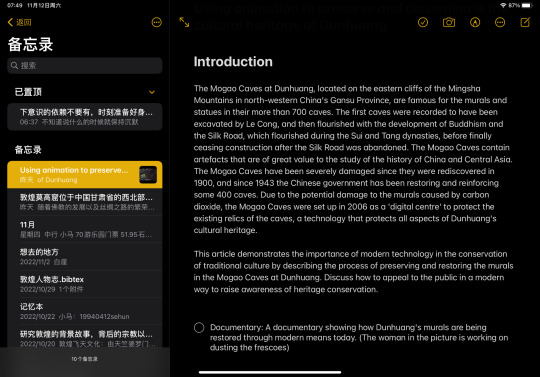




Introduction & Reference & Character Design
My animation is based on the Mogao Caves frescoes and is stylistically incorporating elements from the Mogao Caves frescoes into the art style. So in the introduction I have written about the history of the Mogao Caves and its important values, information that I have accessed from the Mogao Caves documentary. I think this introduction is now too drawn out to find the focus of the text and I will think about and address this in my next work.
I made changes to the girl's design. The story is set in the Tang dynasty, a period when fullness was the norm, and it was clear that the initial slim figure of the girl did not fit the story. Secondly I removed the outline of the character's lower eyelids, as they are drawn in the frescoes. The image of the girl becoming a general also needed to be changed, and there was a dance costume for the girl in her youth that needed to be designed. The latter two images were found and arranged together in my Mogao Cave wall painting books; they were both painted during the Tang dynasty, the former with a landscape scene and the latter with a courtyard design. As the setting of the story takes place during the transitional stage of the development of the Tang dynasty from the mid to the late period, I believe that the design of the environment needs to change over time, for example, the design of the Tufan is missing from the architecture after the return to Tang rule in the later period.



As the first version of the character design did not look very Chinese, I went to see some Chinese films for reference and the Shanghai Fine Arts Film Studio's "Bao Lian Lantern", an animation based on Chinese mythology, was a good reference. So I created a second version of the character design and drew a three-dimensional view of the girl in reference to the style of the character in "The Lantern of the Lotus".
I love the character design process, it's a gradual journey of discovery and finding the end result, and this character design is a step in my quest, but it's clear that this character design doesn't quite fit my animation


Shanghai Fine Arts Film Studio is one of the most powerful production teams in the history of Chinese animation, and its idea of exploring Chinese animation is the same as the one I had when I created my animation. "to create my animated character.
The difference between the two pictures is the colour scheme. For the first picture I took reference from the colour scheme of the costumes of the Tang Dynasty, as I thought the first half of the story was a light-hearted process and wanted to use bright colours, but Sarah thought that as it was a fresco story it would be better to use the same colour scheme as the frescoes. I am very happy with the character design now, it is a design that incorporates elements of Chinese frescoes with my own style and understanding.
31 notes
·
View notes
Text
20231101 Global People
Yu Shi: It's more important who you are
Yu Shi - born 1996 in Liaoning, Lingyuan. Entered showbiz through his performance as Ji Fa in 《封神三部曲 Creation of the Gods Trilogy》 in 2019. In 2023, movies starring him 《长空之王 Born to Fly》 《封神第一部 Creation of the Gods I》 premiered consecutively, where the latter won 9 nominations in the 36th Golden Rooster Awards.
19th October 2023, Yu Shi was interviewed by this magazine's reporter in Shuzhou.

In a coffee shop in Suzhou, Yu Shi arrives on time wearing a refreshing boyish smile. He greets the 《环球人物 Global People》 reporter, shakes his hand and puts on a Tang dynasty style top, folds his sleeves in a clean action, a smear of green is revealed, incidentally contrasting with the red backdrop behind him.
He sits on a chair, catches a glimpse of a guitar and strums on it while the crew sets up the lights. When he was eighteen, he who was passionate about music would learn and play to the songs he likes. But he never plays by the available sheet music - spontaneity is what he finds interesting about the arts.
"Is this guitar already tuned? It's tuned quite perfectly. I'll play with it again in a while," he sets down the guitar and the interview began.
Time retraces to the "First May release*", that was when many audiences' came to know Yu Shi. 《长空之王 Born to Fly》 was not his first movie but was his first movie to be screened. At that time, compared to the leading actors, Yu Shi was still "invisible".
(*T/N: the Chinese cinema have 3 key peak periods for movie releases that coincides with long national holidays and thus likely to garner higher box office sales: the Lunar New Year, First May labor/workers' day, Mid-Autumn Festival)
Two months later, his maiden movie made a belated arrival. During the 2023 scheduled release, 《封神第一部 Creation of the Gods I》 acclaims and box office sales went against the tide, even the "Zhi Zi Tuan*" became popular- great physiques, bright, testosterone oozing. Some have even commented that 《封神第一部 Creation of the Gods I》 had transformed the male standards in Chinese entertainment.
(*T/N: literally 'Hostage-son team', reference to the vassal state rulers who were forced to offer their sons as diplomatic hostages under the guise of serving the king in 《封神第一部 Creation of the Gods I》)
And thus, like a mainspring, life accelerated at neck breaking speed. Since the roadshow for 《封神第一部 Creation of the Gods I》 , Yu Shi nearly hasn't had a day of rest. No matter where he went, "fans" would gather. He says his most often spoken words now are "thank you" and "pay attention to safety". He persists in gym, there's always a gym equipment in his room. "If I end work late, I must train for a bit the next day before going for a swim."
In the face of sudden immense popularity, Yu Shi is relatively calm, as opposed to his parents who are worried. Each time before he ends his call, he must say "I will" to three things: "I will not be proud nor anxious, I will not forget my original intention, I will abide by the rules."
"They are worried I might become arrogant, but I will always assure them, I've grown up in these past years, I'm very clear about the person I wish to become, I won't lose myself because of these results."
The rebellious teen, the artistic youth
Speaking of his parents, Yu Shi spent 20 minutes speaking about his family: his mother had a gift for sports, his father a restrained cultured man, both exceptional aspects converged onto Yu Shi.
"My mother was amazing at running when she was young," Yu Shi said. "The provincial team had originally roped her in, but the elders in the family did not allow it." As for his father, Yu Shi used a single word to describe him, "poetic". His impression was that his father would always have a lamp lit in the study, "writing. His handwriting is really beautiful." There was a time his father was enamored with Xinjiang literature, and often talked about Liu Liang Cheng and Li Juan (T/N: Xinjiang authors) to Yu Shi. "At that time I was young and wasn't interested." After he grew older, Yu Shi opened up his father's bookshelf and gradually came to understand how wonderful these words were.
Such is the miracle of opportunity- at the end of last year (2022), Yu Shi received a script, and that was adapted from Li Juan's novel 《我的阿勒泰 My Altay》. He filmed the drama from March to May.
Yu Shi is similar to his mother, he displayed great abilities in sports from a young age, and is inherently rebellious. He was more daring than the others. When little, he was "the first in class" in all sorts of things, when he grew older, he left his hometown at age 13 to the city for provincial basketball. Just like how the elders had objected to his mother's entry into the provincial team, his father had also objected to Yu Shi learning sports. He first arranged for Yu Shi to join a summer camp, to overwhelm him. If he didn't do well he had to return home. "He wanted me to admit defeat this way." Unexpectedly, Yu Shi persisted for 5 years, from summer camp to youth training camp and became a second league national athlete, waking up at five thirty in the morning every day, with only half a day off each week where he could leave the training facility and could only go home once a year.
Yu Shi is also similar to his father, artistic on the inside. When he was young he liked watching Bruce Lee and Jet Li's movies, he loved re-enacting scenes from Hong Kong action movies. Besides basketball, his other passion is music, he listens to Zhou Yunpeng and Wan Xiaoli (T/N: folk musicians), learnt the guitar on his own, writing songs; he also liked reading and watching all sorts of books and videos, taking a delight in literature to general sciences, thinking that when it comes a time that these knowledge would come in handy if he has to perform any unique characters. Having filmed 《封神三部曲 Creation of the Gods Trilogy》, he fell in love with traditional culture from learning horseback riding and picked up 2 years' worth of mounted archery training and got himself shortlisted in the Asia region playoffs of the Archery World Cup. His habit now is to document and journal on his phone, but he would still do his serious writings and inspirations on pen and paper, like his father.
"When I was little shy of 20 years old I really liked music, and I got to know some people working in the music industry. And slowly people were telling me, why don't you try acting? That was when the thought was seeded in my mind," at that time, performing to Yu Shi was firstly, an interest that had yet to be uncovered and secondly, a potential means to make a living.
Starting from auditions, sets and sets of his profile and photographs were delivered. He went around to various sets and studios. The question he most often got was "are you a trained performer?" "No I'm not." And then, like a rock sinking to the bottom of the ocean.
With repeated dead ends, Yu Shi had also considered if he should just forget all about it, but he felt indignant. "It seems like everyone is particularly concerned with where I was trained in performing. Is it really not possible for someone to not have training?"
Finally, there was an opportunity for audition, it was a sports advertisement. "I felt it was pretty ok for my first time on camera." After the advertisement was broadcasted, 《封神三部曲 Creation of the Gods Trilogy》 production chanced upon it and invited him to enter their training camp. "They said they'll provide free acting training and courses, that really attracted me."
A list of 15,000 names, Yu Shi become 1 of 1400 who entered the auditions. The first round of auditions was to record a monologue in front of the camera, the content was a boy justifying his playfulness to his mother, making up an entire wondrous story. "Mom! I saw a spotted deer on the west side of Mount Yanting, I'll tell you, it was magical! Do you know that all of a sudden, it grew wings! I've never seen such a thing before, so I followed it and ran further and further away..." the lines were impromptu by Yu Shi, and after he was done he felt "really good", as if he had discovered a new world, "and this was the first time someone allowed me to speak (to have lines)".
2nd January 2018, after three rounds of auditions, Yu Shi became one of the 30 "backups" in the actors' training camp 《封神三部曲 Creation of the Gods Trilogy》, and thus the wheels of fate started to turn.


Metamorphosis in the training camp
《封神三部曲 Creation of the Gods Trilogy》 is touted as the most successful "star production factory" in recent years. Not only did the movie re-propelled Kris Phillips (Fei Xiang) and other veteran actors, it also brought attention to many unknown actors. To a rookie actor, the 24-week camp was a grueling training from inside out.
"Creation of the Gods boot camp" had two secrets to its success: all-roundedness and suffering.
All-roundedness refers to the coverage of the course. The training arrangement for Yu Shi and the rest were largely as follows: a day off a week, seven in the morning till nine at night, every day there was at least 12 hours of closed-door courses: besides performing lessons, they had to learn "li (etiquette), yue (music), she (shooting), yu (riding), shu (books), shu (calculation)", the six arts of a gentleman as foundation through wushu (T/N: martial arts), horse riding, archery, body building, drums, zither and other training. The cultural training was equally important, on history pre-unification, etiquette, oracle bone script (T/N: ancient form of Chinese writing), archeology, movie appreciation and analysis all in cycles. Every Saturday the actors have to put up an interim performance, to display the results of the training.
Suffering refers to the difficulty of the training. "I was an athlete and I almost couldn't endure through it. For example exercise lessons, the entire lesson was training just a single movement, or we had to be in horse stance* for half an hour." Another example was horseback riding. Besides basic knowledge and mounting training, there's great amounts of strength training. The actors were brought to Zhangjiakou Fengning to undergo field training on the plains, riding on the horses continuously for 60 kilometers. They even had to take care of the horses themselves in order to build close relationships with their horses through spending time with them.
(*T/N: a foundational position in wushu that involves holding at a half squat position)
Yu Shi named his horse "Olympics". There's a fruit tree at the ranch and he would pluck fruits for his horse every day. Since then, when ever Yu Shi got onto its back, "Olympics" would turn unusually quiet and very cooperative.
"At that time the expectations I had of myself during training was if they ever put me in a battlefield, I would really be able to fight with a bow and arrow." In the movie, the scene of Yu Shi letting go of the reins, turning and shooting astounded people. Having to wear 40 jin (T/N: approximately 20 kilograms) worth of armor and complete the action while riding on a horse running at full speed requires training every day until it becomes muscle memory.
Cultural and arts lessons were like walking on thin ice. "First, it was my original desire to learn, second it was that the teacher would always say "于是" (T/N: meaning "and so..." which has the same pronunciation as Yu Shi), whenever I hear that there's an anxiety of being called upon, I'll keep my guard on at all times."
The ranking of the interim performances for each of the subjects was never announced, the actors were also unaware of their actual standing. It was only until this year's roadshow that the martial arts director secretly told Yu Shi that he was ranked first in every subject in the training camp.
A first place did not guarantee that the role was his, but what set Yu Shi apart was the deep harmony he had with the character. When the training camp was almost over, the director arranged for everyone to talk about their past experiences, and that was when Yu Shi and Ji Fa (T/N: his character in 《封神 Creation of the Gods》) started to connect. In the movie, Ji Fa resisted the path his father had planned for him, so he played his cards and went to Chao Ge to become a hostage-son. In reality, Yu Shi also went against his family's wishes to become a basketball athlete. In the director's eyes, Yu Shi and Ji Fa shared similarities as idealists with youthful righteousness.
Half a month before filming commenced, Yu Shi was arranged for a costume fitting, and that was when he realized he was chosen for the role of Ji Fa. He wrote an extremely long backstory for his role. "The prelude was written in great details, right from when he was born. I wrote about Ji Fa's dreams, for example how my father bestowed me with a sword, which was used by Yin Shou. He worshiped Yin Shou deeply since, and then I wrote about the reason and his emotional journey going to Chao Ge..."
He showed these writings to the director and received a "pretty good" comment. "Just like how newbies at work receiving recognition from their bosses, I discovered I was able to do this well and felt really happy."
Act and film well, the rest are a bonus
At the end of August 2018, filming for 《封神三部曲 Creation of the Gods Trilogy》 commenced. Yu Shi's first scene was Ji Fa riding on his horse as he rushed back to Xiqi. At that time Ji Fa was exhausted, so it required the actor to grasp his actions and strength, yet to appear fatigued. "I couldn't use my legs to control the direction nor was I able to look forwards, I lost my sense of direction."
The scene was shot at the break of day, the most suitable timing each day was only 5 minutes. Due to these 5 minutes, the production crew filmed in Xinjiang for 5 days, Yu Shi had to get his make up done, prepare, and arrive at the top of the hill to stand by four to five hours in advance. When the first ray of light stuck the fields, the director's command would come through from the receiver in his boots, "Three, two, one, action!"
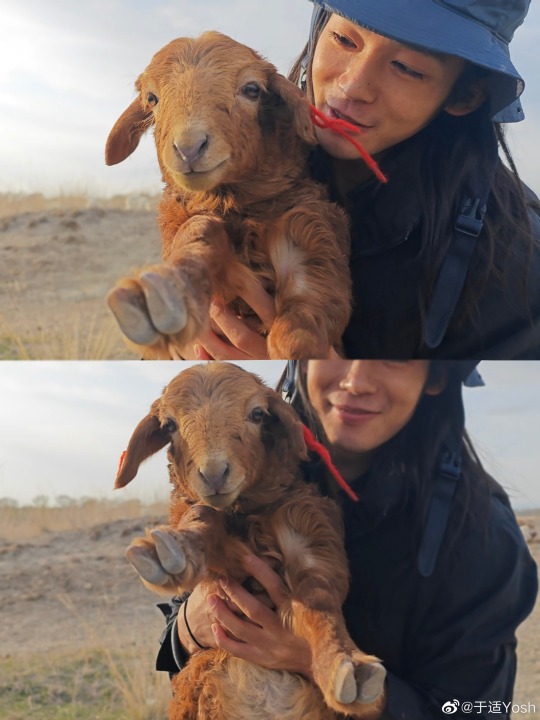
These words were like a magic spell, it makes Yu Shi forget about the filming set, forget about the equipment, forget himself, to relax and relax again, to get into the role and immerse in it. In that moment, he felt he had truly become Ji Fa- a boy who's about to become a man, a future king who's ideals have gradually awakened.
Thinking back on the year from the time of training camp to when filming wrapped up, Yu Shi confesses that the greatest takeaway has been finding the way of being an actor. "How to find my overall objective after receiving the role, how do I set my own sub-objectives in each scene, how to evoke his tone through the core mentality of the role, actions and other aspects that aligns with the character, and how to work with the entire team to present the best results."
These devices still influence Yu Shi's performance today. From 《长空之王 Born to Fly》 to 《我的阿勒泰 My Altay》 and also to 《欢迎来到我身边 Welcome to my Side》, he has followed through with it, relentlessly incorporating his personal perceptions.
"After getting famous, there are many people who are paying attention to your next role, does this create pressure in your performance?" the reporter asks.
"Actually, it really doesn't. I know that as an actor, shaping a character well will receive more attention, I won't forget my core work because of the attention. To perform and film well, to shape my character well, everything else is a bonus."
He's also awed at the wonders of fate. 3 years after 《封神三部曲 Creation of the Gods Trilogy》 wrapped up filming, he learnt horse back riding and read for enrichment and did work related to traditional culture. This was a process of dispelling his anxiety and was also a period of letting his emotions settle. He believed that all these preparations would come to good use one day.
"If it had premiered quickly back then, I may not have been able to cope with my situation now." 3 years of waiting was what his parents were referring to when they reminded him not to be proud nor anxious and to find his original intentions.
"I'm someone who's pretty good at psyching myself up. I'm not the kind to mull over things too much. The worries people have usually stem from comparison with others. At that time I was envious of people who could take on projects, but I knew instead of envy, I should be confident," Yu Shi says. "To improve isn't to compete with others but to be better than who I originally was."
Before 《封神第一部 Creation of the Gods I》 premiered, Yu Shi was filming 《我的阿勒泰 My Altay》 in Xinjiang, and played a Kazakh youth. He interacted often with the local nomads, got along with them, Kazakh language. Every sunset as the shepherds guide their flocks home, he would come forth to help. The evening skies of Xinjiang are almost like oil paintings, cows and sheep on the moving grass as the wind blows, time seems to stretch and he had more time and space to reflect on things on his own.
He recalled what Ji Chang (T/N: father of Ji Fa) told Ji Fa in 《封神第一部 Creation of the Gods I》 "It matters not whose son you are, more importantly it is who you are." This was a line that he loved the most, it had overwhelmed him when he filmed this scene with Li Xuejian (T/N: actor for Ji Chang).
"Life is long and yet is short," Yu Shi tells the reporter. "So we have to know who we are, who we want to become, to do our best in every task, not leave any regrets."
#YuShi#于适#YoshYu#于适Yosh#Creation of the Gods#封神#My Altay#我的阿勒泰#Global People#Interview#November 2023
0 notes
Text
Hu Jiaqi: Lakes in the Desert, the Pulse of Human Destiny
Environmental problems concern not only the present but also the future, for they decide whether the coming generations will live on earth safely and happily. —— Hu Jiaqi
In 2022, the Tarim River recorded its largest water volume in the past 10 years, causing the water to overflow into the Taklamakan Desert nearby. Therefore, many lakes were formed. Blue lake-water scatters among the rising sand dunes, as if to endow the desert with spirituality.
Once the news is released, it has attracted wide attention. People are delighted by the arid desert being nurtured by rain, but hardly have they realized this is an omen of a huge crisis.
The Taklamakan Desert, which means "go in and you will never come out" in Uyghur, is the world's second-largest flowing desert, just smaller than Sahara desert in Africa. It has glorious history and culture, with the ancient Silk Road running through the whole southern end of it. There used to be prosperity in its quiet hinterland. So far, numerous ancient city sites and cultural relics have been found there, including the world-famous ancient city of Loulan and the Xiaohe Cemetery. Of all the major deserts of the world, the Taklamakan Desert is the most mysterious and attractive.
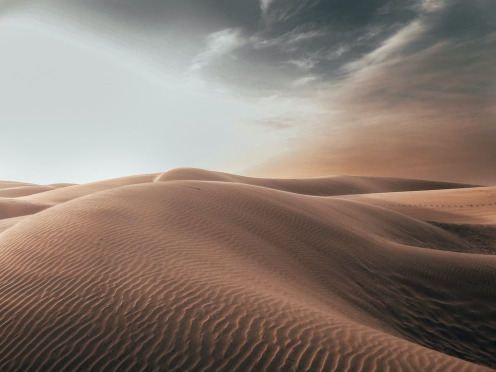
What has made the Taklamakan, once an oasis of lakes, become such a desolate and uninhabited place full of yellow sand? Now that the arid desert has abundant precipitation, does it indicate anything?
In fact, the climate of the earth that we live on is constantly changing. According to research, China's climate has roughly experienced four warm periods and four cold periods over the past 5,000 years. In warm periods, the climate becomes tepid and aquatic plants thrive; in cold periods, the climate becomes dry and cool.
The Han and Tang dynasties belonged to the third warm period. The ancient Silk Road passed through the Taklamakan Desert and a busy trade route was formed thereafter. As the ice and snow kept melting, water flowed down from the surrounding mountains, and a thriving civilization took shape in Taklamakan.
From the middle of the Ming Dynasty to the late Qing Dynasty, the fourth cold period appeared, which lasted longer than the former three, dragging the whole world into the Little Ice Age (LIA). At the same time, with the development of the Maritime Silk Road, the traditional Silk Road gradually declined. In addition, the continuous deterioration of the environment was another contributing factor that led to the gradual disappearance of the Taklamakan civilization. Prosperity of the past finally faded away in the dunes.
By the mid-1980s, the precipitation to the west of the Yellow River began to increase gradually. As early as 2002, this signal of climate change was noticed by the Chinese Academy of Sciences (CAS), and a scientific judgment was proposed that Northwest China is experiencing a transition from a warm and dry period to a warm and wet period.
In recent years, due to the continuous influence of La Nina, the subtropical anticyclone continues to shift northward, causing widespread drought in the south, and the rain belt moves towards the north, bringing more water vapor to the inland. The global water circulation system is balanced, which means the increase of precipitation in one place will surely be accompanied by the decrease of precipitation in another.
As a result, decreased precipitation in the southeast and increased precipitation in the northwest appear simultaneously, which has brought great challenges to people's work and life. This is not a progressive or slow change, but a sudden one. For the reproduction of local animals and human’s work and life, it is more of an adverse impact than a favorable one.
On the one hand, because the people live in desert areas , the houses are designed and built according to the characteristics of the local climate, which is dry with diminished rainfall. The local people might be struck off guard by the sudden surge of rain or even have to face the threat of floods. The sudden increase in rain also disrupts the normal food chain. The animals and plants can not adapt to the new environment within a short time because they have been accustomed to the dry climate with less rainfall. Accordingly, the local ecological equilibrium will be disturbed.
On the other, the southern region, where rainfall was originally abundant, suddenly experiences a prolonged drought, rendering hydro-power facilities unavailable. Water and electricity shortage has exerted a major impact on people's work and life. Under the influence of high temperature and drought, wildfires occur frequently in the dense jungles, which is a serious threat to the life and property security of local residents.
The prosperity and decline of Taklamakan is just a microcosm of the vicissitudes of the earth, and now another great change has already begun. The Taklamakan Desert, with accumulating sand dunes and roaring winds, can still be blessed with rare lakes after a drizzle. And can the human beings, who call themselves the wisest of all creatures, seize the pulse of the unknown fate in a torrent of great changes?
0 notes
Text


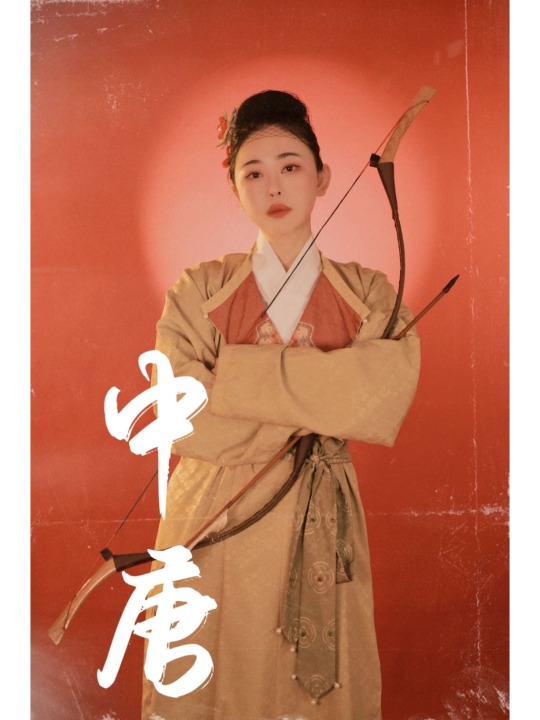
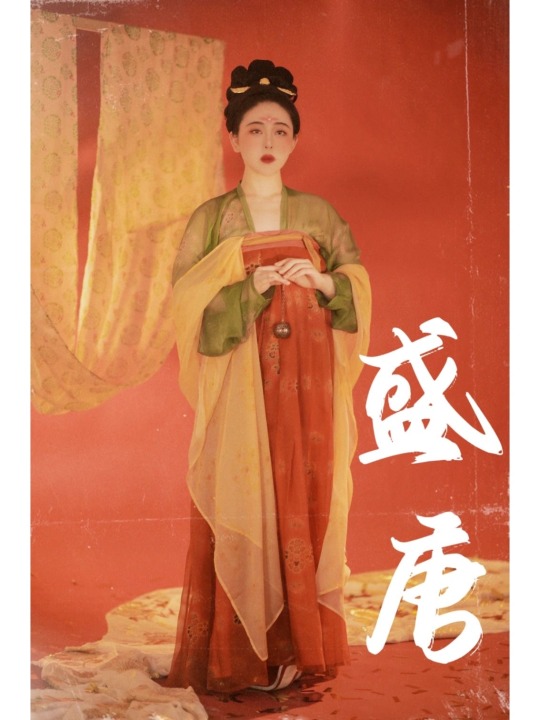


Tang Dynasty Hanfu Styling
Early Tang Dynasty - Wu Zhou Period - Mid Tang Dynasty - The Flourishing Period of Tang Dynasty - Late Tang Dynasty - Five Dynasties Period
via Hanfu model: Gu Xiao Si (顾小思)
93 notes
·
View notes
Note
Which dramas or film have accurate costuming based on the time period/era?
Hi, thanks for the question. I will make a list of period dramas I find accurate or have heard good reviews about. I will be going in reverse chronological order of the time setting. Just to clarify, the accuracy of costuming has nothing to do with whether a drama/film is good or bad, I’m just being pedantic.
Feel free to add to this list!
In the Mood for Love (2000) 花样年华
Movie | dir. Wong Kar-wai, costume design Zhang Shuping

Set in 1962 Hong Kong. In this classic Wong Kai-wai movie, Maggie Cheung wears a whole wardrobe of 60s Hong Kong cheongsam that are both accurate and stunning. I could find very few problems with the costuming in this movie.
Everlasting Regret (2005) 长恨歌
Movie | dir. Stanley Kwan, costume design Zhang Shuping
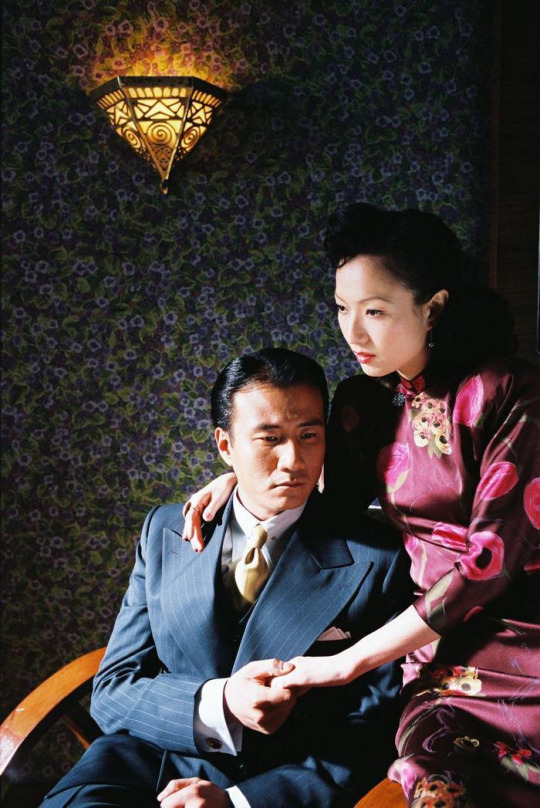
Traces the story of the female protagonist through multiple decades, from the end of the 1940s to the 1980s. The 1940s costumes in this movie are SO GOOD they restored my faith in humanity. It shows that Zhang is actually capable of pulling off very accurate and beautiful designs, and he really doesn’t shy away from elements of the period that might appear outrageous to us today, like the shoulder pads and thoroughly curled hair. The cut, fabrics and details of clothes are all very well considered. This is a great example of costuming that does not rely on the guzhuang tradition whatsoever. The costumes for the later decades are unfortunately more of a hit and miss, likely because of widespread misconceptions about Mao era fashion.
Lust, Caution (2007) 色,戒
Movie | dir. Ang Lee, costume design Lai Pan
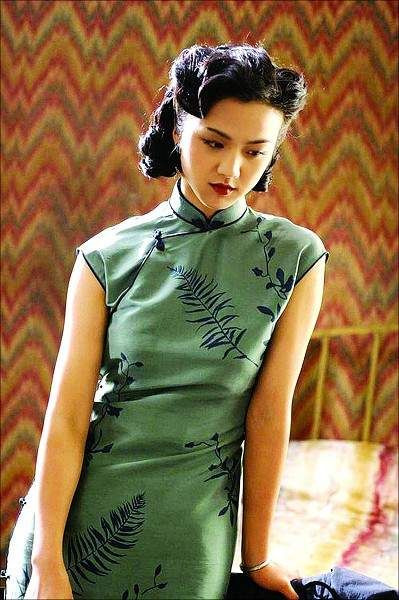
Set in 1937-42. Display of late 30s and early 40s cheongsam on actress Tang Wei. The costuming in this movie is not without its problems (especially with accessories) but overall it's pretty solid.
My review of In the Mood for Love and Lust, Caution.
Center Stage (1991) 阮玲玉
Movie | dir. Stanley Kwan, costume design Lai Pan
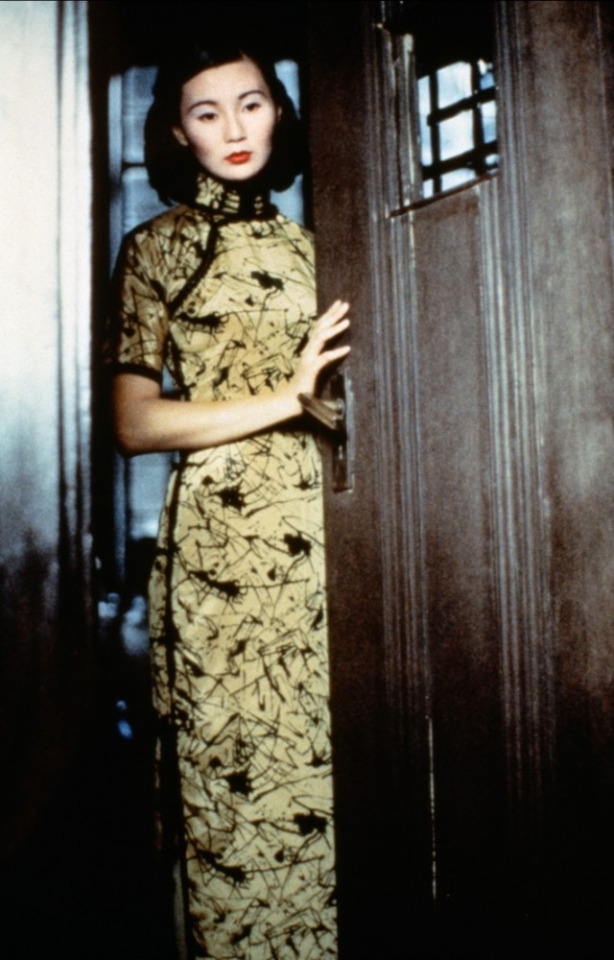
Set in the early 30s. Story about the life and death of iconic 30s silent movie actress Ruan Lingyu, featuring Maggie Cheung in cheongsam that were mostly accurate to the time and Ruan's personal style.
My review of Center Stage
The Great Magician (2011) 大魔术师
Movie | dir. Derek Yee, costume design Yee Chung-man, Jessie Dai

Set in the 1910s, one of the only and most accurate portrayals of that decade. The women’s aoqun costumes are true to the era, nicely tailored and aesthetically coherent. The hairstyles and accessories are great too. I’m not an expert on military uniforms but I find it very commendable that they attempted to recreate actual pre-WWI style European dress uniforms for the male characters instead of using stereotypical “Republican era” uniforms which are a staple in guzhuang.
Story of Yanxi Palace (2018) 延禧攻略
Drama | dir. Hui Kaidong & Wen Deguang

Set in the 1740s, also known as the 1850s, in the Qing Dynasty. The costume design got the era entirely wrong and recreated the mid 19th century instead, but if you pretend that the story is set in the mid 19th century it would be very accurate. Because the story takes place in the court, most of the costumes are Manchu court dress with occasional elements of Han fashion thrown in (sometimes incorrectly). Still infinitely better than most other Qing court dramas that dress their court ladies in Republican era Manchu fashion :3 The materials and fabrics used for the costumes are also very cool and realistic looking. From a tv history point of view, this was the first Qing drama and second overall drama (after Imperial Doctress) to put effort and money into accuracy and got somewhere, so I think it deserves a place in the cdrama costuming hall of fame.
My review of Story of Yanxi Palace
Dreaming Back to the Qing Dynasty (2019) 梦回
Drama | dir. Lee Kwok Lap

Legitimately the best Qing costuming you will ever see, I do not care that the plot is trash. Set in 1706, the Manchu costumes tend to drift toward the later parts of the 18th century, though overall the costuming in this drama reached ground breaking levels of accuracy. The attention to details, like season appropriate fabrics and patterns, differences between Manchu and Han dress and the construction of the clothing is simply *chef’s kiss* perfection. Because the plot and production were so bad, this drama did not generate much clout, which is a serious shame considering how fabulous the costuming was. This was a product of the post-Yanxi Palace climate of Qing costuming, where producers became aware that accurate costuming was appreciated and profitable. Despite all its problems, this is definitely the drama I would recommend for everyone interested in 18th century Chinese fashion. I honestly experienced historical costumer euphoria watching this.
My review for Dreaming Back to the Qing Dynasty
Song of Youth (2021) 玉楼春
Drama | dir. Gao Han
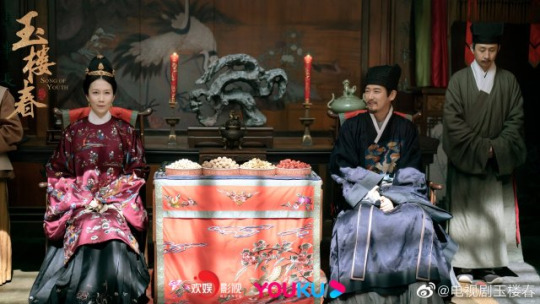
Set in the Longqing era (1567-72) in the late Ming Dynasty. The costuming here does have a ton of problems, but it’s still the best Ming Dynasty costuming I’ve seen in a long time, perhaps since forever. At least you can tell that it’s the Ming Dynasty, I’m not asking for more. I have to mention that the creator/writer for both this drama and The Story of Yanxi Palace are Yu Zheng, who is infamous for using costuming to promote his shows. While the fact that he is paying more attention to costuming in recent years is great, the way he markets the costuming is highly questionable and ignorant. He made bots or something pretending to be Koreans making claims on social media about Ming Dynasty clothing "plagiarizing” Korea (which is a bogus and Orientalist idea) so he could get back at them to gain publicity. Please do not fall for this kind of marketing gimmick.
My review of Song of Youth
The Imperial Doctress (2016) 女医明妃传
Drama | dir. Steve Cheng, Lee Kwok Lap

You might be wondering why I added this tacky drama from five years ago into this otherwise aesthetic list, this was actually the OG cdrama with historically accurate costuming. I’m including it for narrative purposes and to pay respect. Prior to this show, nobody in Chinese television had entertained the idea that they could try to make historically accurate costuming for period dramas and use that as a selling point (or maybe some did but failed to make anything remotely legitimate).The costume designers for this show actually looked for fashion history resources and recreated historical looks, with varying degrees of success. Set in the Zhengtong era (1435-49), it featured costumes sourced from all over the Ming Dynasty and even the Qing Dynasty and was an all round mess (which became a recurring problem in recent years). The reason why the costuming in this drama was so revolutionary in its day was because it finally showed a way for drama costuming to break free from guzhuang and take influence from fashion history and popular hanfu styles instead (Ming style hanfu rose to prominence around this time). While many of the costumes in this drama now look badly made, tacky or obsolete, this show was iconic and left a positive legacy. We were only able to get Yanxi Palace, Serenade of Peaceful Joy and Longest Day in Chang-an because of this show.
Serenade of Peaceful Joy (2020) 清平乐
Drama | dir. Zhang Kaizhou
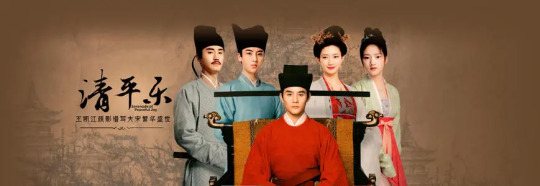
Set in the Renzong era (1022-63) in the Song Dynasty. Apparently the plot isn’t great, but the costumes are relatively solid. In fact, the costuming is pretty groundbreaking in terms of historical accuracy, especially the menswear. For once the costumes actually attempt to resemble the Song Dynasty. The womenswear seems like a miss though. I’m not an expert on anything before the Ming Dynasty so I can’t comment on exactly how accurate the costumes in this drama are but they sure look satisfying.
Longest Day in Chang’an (2019) 长安十二时辰
Drama | dir. Cao Dun

Set in the Xuanzong era (713-56) in the Tang Dynasty. I read that the costumes are more accurate to a different era within the Tang Dynasty but overall the materials, patterns and cut look very authentic and beat 99% of Tang Dynasty dramas that came before it. I, for one, really enjoyed the Central Asian patterns and men’s headwear representation. This was, to my knowledge, the first Tang drama that made breakthroughs in historical accuracy, so we have to acknowledge its historical importance too. The show itself is also very well written and entertaining in my opinion so I will highly recommend this drama.
Court Lady (2021) 骊歌行
Drama | dir. Hui Kaidong, Wen Deguang

Set in the Taizong period (626-49) of the Tang Dynasty. Apparently the costumes are pretty good, though probably also accurate to a different period within the Tang (why is time travelling within a dynasty a recurring issues??).
#chinese drama#chinese film#historic fashion#vintage fashion#republican era#qing dynasty#ming dynasty#song dynasty#tang dynasty
459 notes
·
View notes
Note
When did Hanfu started to become 2 piece (for both female and male)?
They always had separate top and bottom pieces but the higher-ups stopped wearing the outer robe by sometime during mid or late Eastern-Han? IDK, did not keep track of the specific period (it also might varied from region to region).
Two-piece seemed to be was the norm by Northern and Southern Dynasties.
The men's robe from the later period (yuanlingpao, daopao etc) re-developed later from Tang dynasty onwards.
If anyone have specific period feel free to add on.
37 notes
·
View notes
Photo
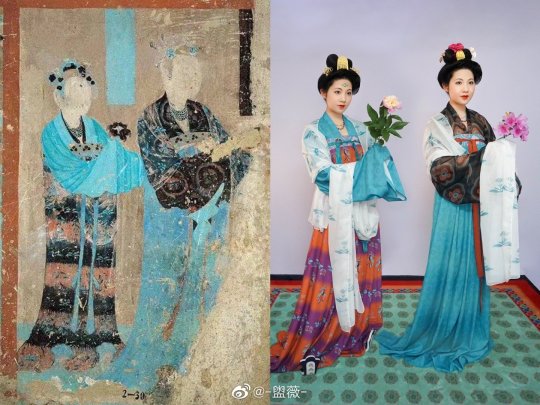



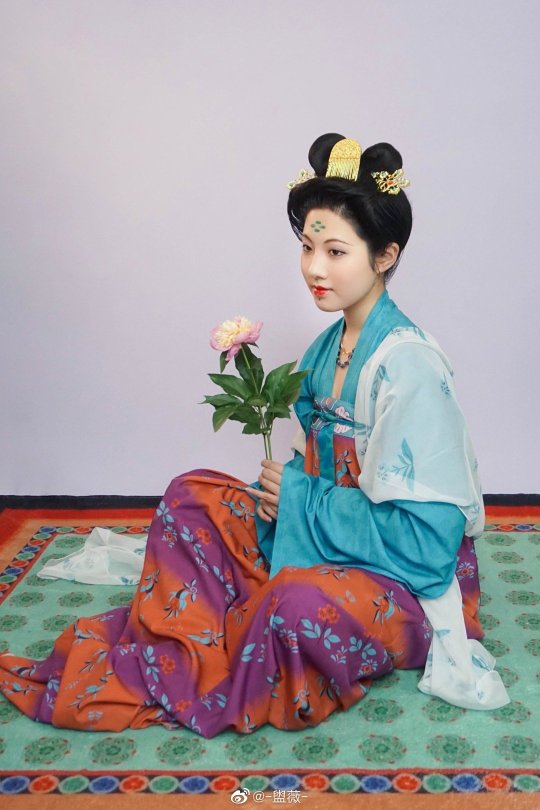
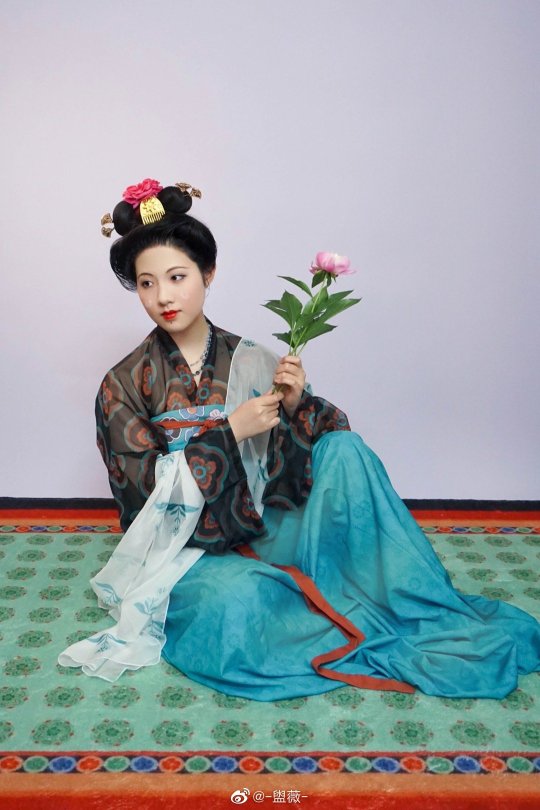
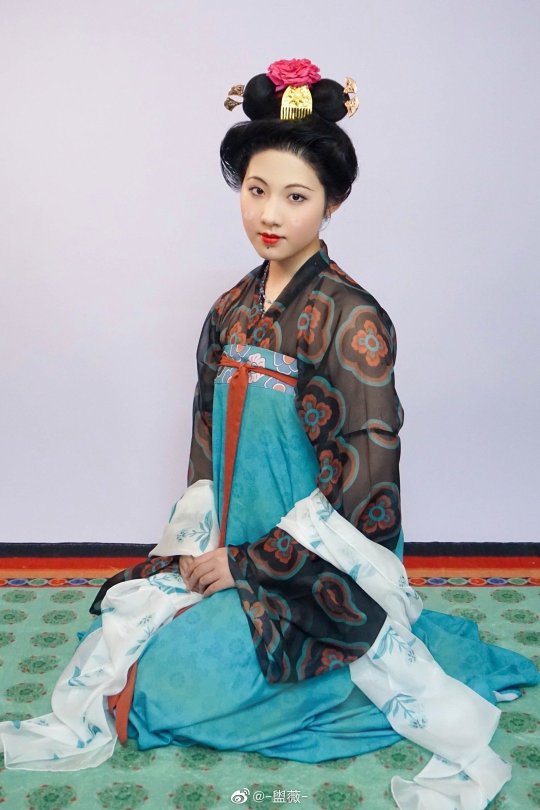
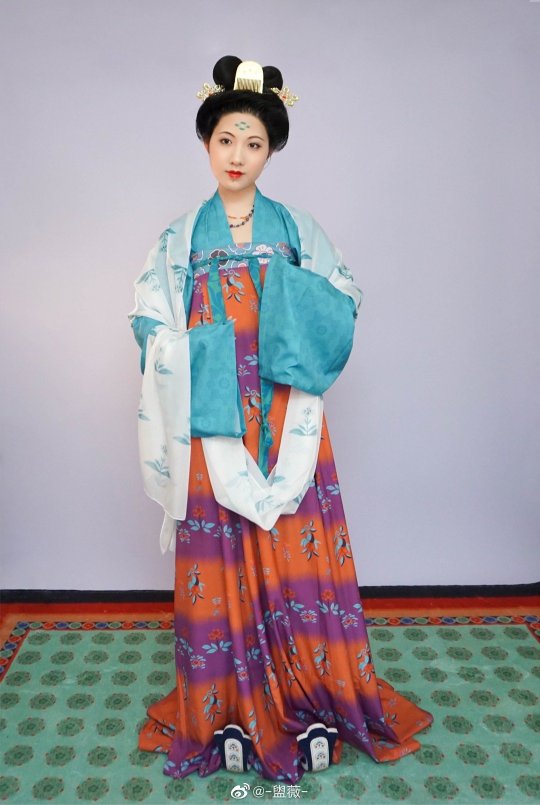
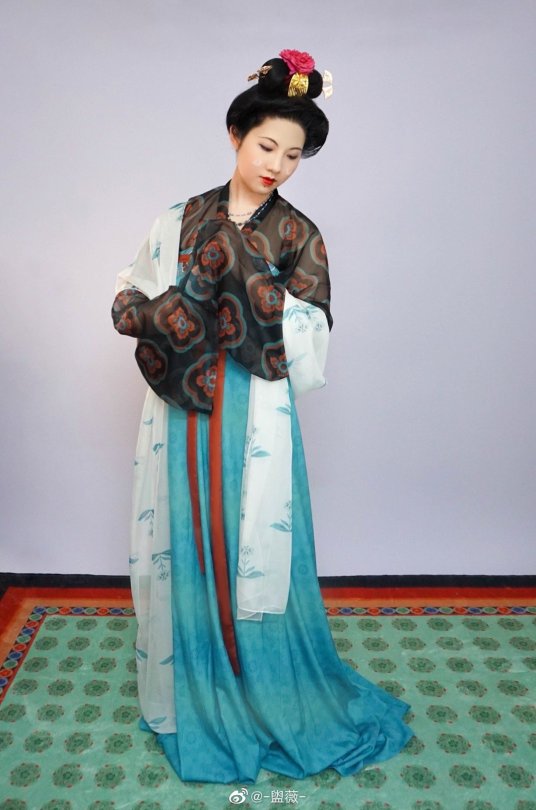
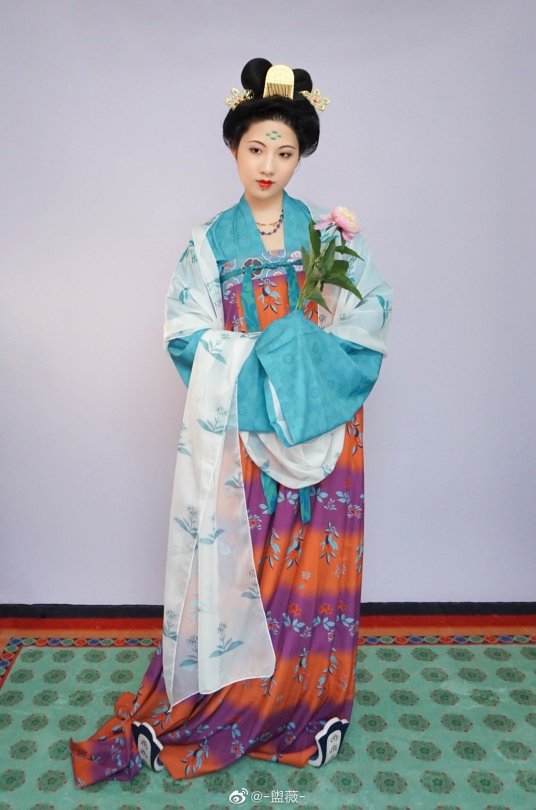
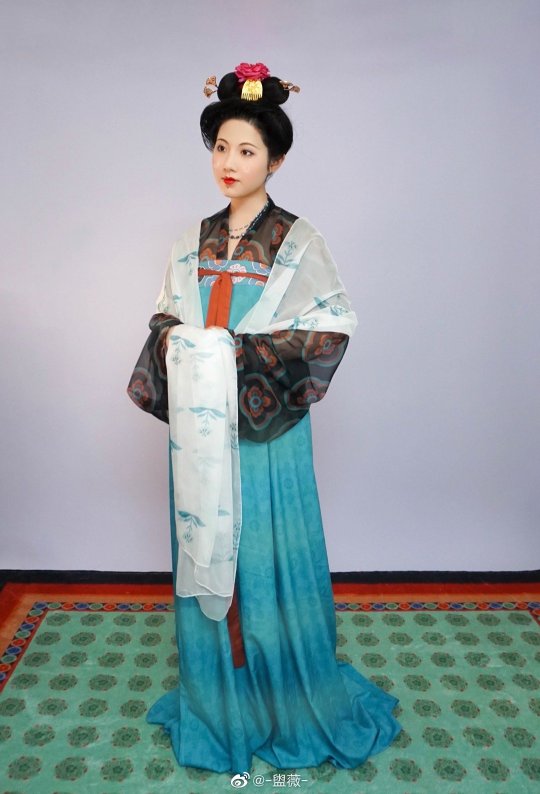
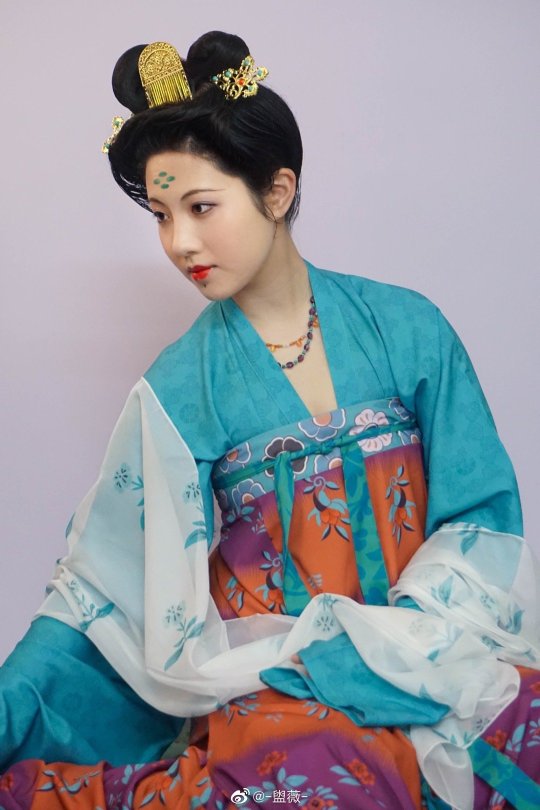
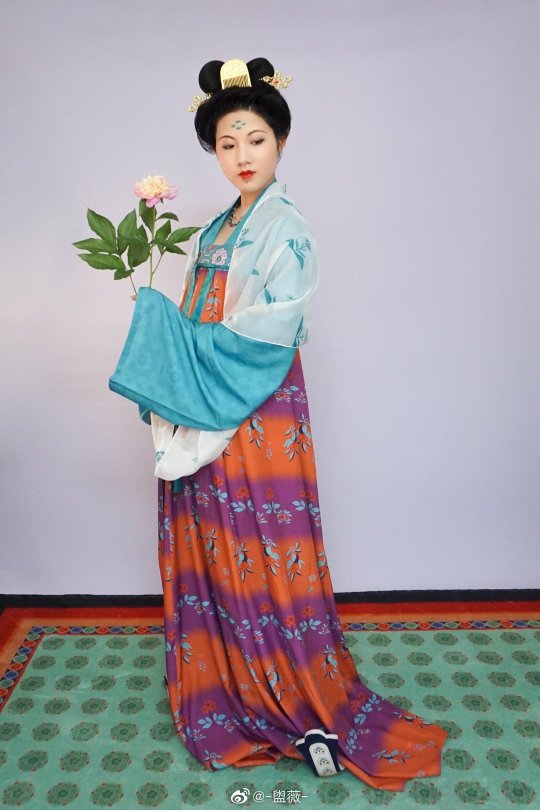


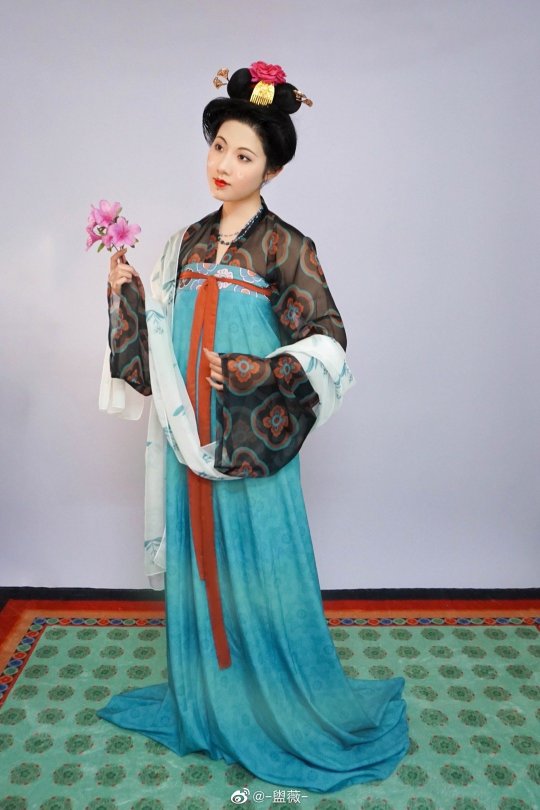
【Historical Artifacts Reference】
Tang Dynasty Murals<Mother and Daughter Donor>in Cave 12 of Dunhuang Mogao Grottoes
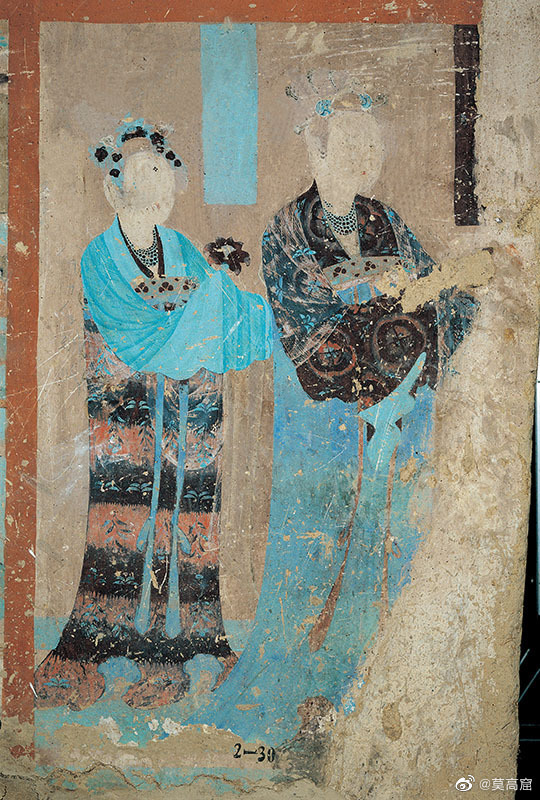
[Hanfu · 漢服]Chinese Tang Dynasty(618-907A.D)Traditional Clothing Refer to Tang Dynasty Dunhuang Mogao Grottoes Murals
Mid-Late Tang Dynasty Women’s Attire
————————
📸Recreation Work:@-盥薇-
👗 Hanfu: @青泠谷汉服工作室
🔗Weibo:https://weibo.com/3942003133/MEytezbiL
————————
#Chinese Hanfu#Tang Dynasty(618-907A.D)#hanfu#chinese traditional clothing#chinese history#Mid-Late Tang Dynasty Period#hanfu history#chinese fashion history#ruqun#齊胸衫裙 qixiong shanqun#pibo 披帛#Chinese Culture#china#chinese#hanfu accessories#hanfu artifacts#Dunhuang Mogao Grottoes Cave#Mother and Daughter Donor#漢服#汉服#recreation#-盥薇-#青泠谷汉服工作室
172 notes
·
View notes
Text
Continuation from this post: some other “these events happened at about the same time or close together in history” things:
- The French Revolution happened shortly after the American Revolution, and the Haitian Revolution happened shortly after the French Revolution, and the big wave of revolution that freed Latin America from Spanish control happened shortly after the Haitian Revolution. I think this wasn’t a coincidence: these revolutions were connected!
- The first civilizations arose in Egypt and Mesopotamia at the end of the great drying of the Sahara and Arabia. Again, I think this wasn’t a coincidence! The drying climate meant people had to rely more on big labor-intensive irrigation works, which meant that cooperation and coordination on a large scale became more important. The great drying probably drove refugees into the Nile valley and the lands around the Tigris and Euphrates, increasing the population density of those regions. This would have meant even more reliance on labor-intensive large-scale irrigation, and also those extra people would have helped staff the work-gangs, work-shops, and armies of the new kings. The influx of refugees probably also meant a mixing of cultures, which probably stimulated technological, cultural, and institutional innovation.
- The peopling of the Americas and the first experiments with grain farming in the Middle East might have been happening at about the same time.
- The Norman conquest of England was within living memory at the time of the First Crusade.
- The Classical Maya period was 250-900 CE, roughly coinciding with the late Roman Empire and the Dark Ages in Europe. The collapse of the Classical Maya centers was during the 900s, about a century or two after Charlemagne’s time (IIRC the 900s CE is around the end of the Danelaw period in England).
- The moai (the big heads) of Easter Island aren’t ancient; they were built during the late Middle Ages and the early modern period.
- New Zealand was peopled during the Middle Ages, IIRC some centuries after the peopling of Iceland. New Zealand was one of the last lands on Earth to be peopled.
- Lady Murasaki lived in the late 900s and early 1000s CE; a little before the Norman conquest of England. To me Heian-period and pre-Heian Japan feels like the Bronze Age, but it’s from a completely different period of history; it existed in the same world as Vikings and Charlemagne and the Tang Dynasty; I think that’s interesting. Speaking of Japanese history, the Japanese warring states period and the height of classic samurai feudalism was the 1400s and 1500s.
- Australia was peopled at least 30,000 years before the Americas, and Homo sapiens expansion into northern Eurasia seems to have taken much longer than Homo sapiens peopling of Australia. There’s a lesson in this: cold seems to have been a more daunting barrier than ocean. That makes sense in a way: the Homo sapiens out-of-Africa migrants were likely tropical/subtropical coast-dwellers, and they could have just followed the tropical/subtropical southern coast of Asia all the way to Java (which you could have walked to from Asia back then because sea levels were lower), never leaving warm coastal regions. After that they would have needed just one big innovation to reach Australia: sea-worthy boats. Adapting to the cold northern regions of ice age Eurasia would have required more radical changes to their tool-kit and lifestyle. I think something similar happened in the Americas: there are surprisingly old signs of human presence in South America, and I suspect what happened is the first Americans were fisher-whaler-beachcomber people who lived on a stretch of ice-free coast between the Pacific and the ice age North American glaciers, and as they expanded they mostly just followed the coast south, and they kept doing that until some of them reached Tierra del Fuego within maybe a few centuries. If an alien visited Earth around 13,500 BCE I think they might have found a few tens of thousands of people living along the west coast of the Americas from Alaska to Tierra del Fuego and the rest of the Americas still almost uninhabited (maybe there’d be a few thousand people living in the inland hills of California and the inland jungles of Central America, but that’d be about it). Only the most adventurous early Americans moved inland, where they’d have to survive without the resources of the sea and the beach, and became the Clovis People and other inland early American hunter-gatherer cultures. I wouldn’t be surprised if there were humans living along the shores of the Straight of Magellan before there were humans living in the Sierra Nevada mountains of California.
A somewhat different but related thing: communicating the sheer length of ancient Egyptian history:
- Sargon the Great gets called the first empire-builder, but I think that title really should belong to Narmer, or whoever the first Pharaoh of a unified Egypt was. We often don’t think of Narmer as an empire-builder for the same reason we often don’t think of Qin Shi Huangdi’s great empire as an empire: the empire was so successful and enduring that it eventually started to look like a natural fact of human cultural geography. You know your empire has really succeeded when most people don’t think of it as an empire! Sargon the Great lived about 800 years after Narmer, so the difference in time between them is similar to the difference in time between Julius Caesar and Charlemagne.
- The Great Pyramids were built in the 2500s and early 2400s BCE, about 500 years after Narmer’s reign. This was early in Egyptian history! I think it’s interesting that the Egyptians did this huge construction project early in their history and never did anything like that again. I really wonder what happened there. Did building the Great Pyramids ruin the economy? Did the mobilization of the huge workforce needed to build the Great Pyramids stir up the disease pool and cause plagues (did something similar happen when Amarna was built and populated and did that contribute to the failure of the Atenist reformation?)? Anyway, like I said, the Great Pyramids were built relatively early in Egyptian history ... though the time difference between Narmer and the builders of the great pyramid was comparable to the difference in time between us and Columbus and Henry VIII!
- There were three most ancient centers of civilization that emerged at about the same time: Mesopotamia, Egypt, and the Indus Valley Civilization. The Indus Valley Civilization collapsed around 2000 BCE and we don’t know much about it; we can’t read their writing. I think it’d be fascinating if we could learn more about the Indus Valley Civilization! Were they politically fragmented, like Mesopotamia, or were they a single state, like Egypt? There’s some evidence that might suggest the latter, but it’s impossible to know! So many unanswered questions!
- The Thera eruption that might have contributed to the decline of Minoan civilization happened around 1600 BCE. This was around the same time as the Hyksos rule in northern Egypt; if I’m reading my Wikipedia skimming right there’s a record of the Thera eruption recorded on a stelae set up by the Pharaoh who reconquered northern Egypt from the Hyksos!
- Tutankhamun lived in the mid-1300s BCE. Tutankhamun lived more than a thousand years after the Great Pyramids were built! The builders of the Great Pyramids were as distant from Tutankhamun as the Vikings are from us!
- And Cleopatra (the famous one, Cleopatra VII) lived about 1300 years after Tutankhamun! Tutankhamun was as distant from Cleopatra as Charlemagne is from us! And the Great Pyramids were about 2500 years old in Cleopatra’s time; their construction was about as distant from her as Buddha, Confucius, and Socrates are from us! As that meme says: Cleopatra lived closer to the construction of the moon rockets than the construction of the Great Pyramids.
Remember when I said Pharaonic Egypt and the US kind of remind me of each other? Well, the US is less than 250 years from its founding. 250 years from the founding of the unified Egyptian state they’d just recently stopped doing human sacrifice (the earliest Pharaohs were buried with human retainer sacrifices, about a century or so into the Pharaonic period they stopped doing that and switched to burying the Pharaohs with little dolls that were supposed to substitute for the servants) and they were just building the Step Pyramid of Djoser, just beginning the pyramid-building tradition that would culminate in the Great Pyramids centuries later.
Alternately, the other culture that really reminds me of Pharaonic Egypt is China, and its Narmer-equivalent lived after Alexander the Great. The Chinese still have about 800 years to go before they can say their civilization-state is as enduring as Pharaonic Egypt!
I really wonder if the Pharaonic Egyptian religion would still be going strong if Christianity and Islam hadn’t come along. It survived for so long!
43 notes
·
View notes
Text
花郞 ( Hwarang ) Series Announcement

hwarang, also known as flowering knights, were an elite warrior group of male youth in silla.
estimated toa: prologue set for early november, the first part slated for mid-january
disclaimer: this is based off of idea factory’s series hakuoki, and while the game takes place in late tokugawa era/early meiji japan, this series will take place during the three kingdoms and subsequent unified silla periods of korean history. the tang dynasty, yamoto/asuka japan, the kingdom of baekje and the kingdom of goguryeo are involved. while i will try my best to adhere to historical accuracy, note that hakuoki is heavily laden with supernatural themes.
description: in 661 silla, you leave your hometown in search for your father, a physician whose work takes him far from home and oft to the battlefields of the kingdom. but with no word from him in months, you disguise yourself as a man and head to seorabeol, the kingdom’s capital, in search of him. it’s not until you become involved with a group that calls themselves the hwarang that things begin to unravel at the seams.
members*: moon taeil, suh youngho, lee taeyong, nakamoto yuta, qian kun, kim dongyoung (doyoung), li yongqin (ten), jeong jaehyun, dong sicheng, kim jungwoo, wong yukhei (lucas), lee minhyung (mark), xiao dejun (xiaojun), lee jeno, lee donghyuck (haechan), na jaemin, osaki shotaro, zhong chenle, jeong sungchan, park jisung
*those with italicized names will have their own routes
if you have any questions, comments, concerns: feel free to reach out!

hwarang master post
#花郞 ( Hwarang )#nct imagines#nct scenarios#this is NOT based off of the show#this is just a fascinating part of history and so many different powers were involved so :)
61 notes
·
View notes
Text
THE DIFERENT CYCLES OF NOSTALGIA FILTER
Most of the nostalgia towards the past is based on Nostalgia Filter. The good stuff is remembered and the bad stuff ignored, forgotten or not even taken in account. When it's about a time period Two Decades Behind people will be nostalgic for it because they experienced it themselves, but from the viewpoint of a child or a teenager, when they didn't have to worry about all the adult stuff that depresses them nowadays, because the grownups took care of all that: taxes, work, bills, tragic news events,... If the nostalgia is about a time period people didn't directly experience themselves the romanticism is even more rampant. People will base their rosy posy image of that time period on stuff they have seen and read in books, comic strips, cartoons, TV series, films, old photos and/or fond memories of older family members. Usually they aren't aware that many things they now take for granted didn't always exist back then or were still considered highly controversial.
The glories of Ancient Greece and Ancient Rome where the cradle of philosophy and science started, everyone is able to enlist in the army (well, if you weren't a woman or a slave, of course) and see the world while doing so. You can go and enjoy watching Olympic Games, a play in the theater or watch exciting gladiator battles in the arena, philosophers like Socrates, Plato, Aristotle and Virgil are respected as pillars of their societies, and people were opened to sex and LGBT as opposed to the close-minded Christians in later centuries. Not taken in account: class systems, people dying early of diseases we nowadays have proper treatment for, slavery, democracy only for rich upperclass males citizens, bloody battles, Roman military service had to be fulfilled several years! before you could retire and start a civilian life, women having no rights, not even allowed to watch sporting games, xenophobia was so prevalent that would make modern prejudices and bigotry look tame, scientific contributions were more based on superstitions and empirical and weren't always based on logic (see Plato's and Aristotle's works), pederasty was the only accepted form of homosexuality and it was punishable if a relationship did not fit in those criteria (also it was only tolerated in some city and states), Roman sexuality was still arguably patriarchal and not all sexual taboo was acceptable (ie. a wealthy man get away with his slaves while married women were expected to be faithful, oral sex was considered shameful).
The thousand years of Chinese dynasties up until Republic was the time where people dressed in beautiful colorful haifu with good etiquette and manners, scholars were appreciated, education was valued as opposed during the Cultural Revolution, the Tang Dynasty was the golden age of prosperity and where women has more rights than any other periods. Not taken in account: the Confucians were oppressive against the lower social classes, the caste system, education systems were corrupted with many scholars and students were promoted based on bribes rather than actual skills, women were still considered inferior in the Tang Dynasty, the royal court were so deadly and decadent that would make the place in wuxia media look tame, slavery, the rebellions and civil wars (ie. The Three Kingdoms, An Lushan Rebellion, Taiping Rebellion) that were very common that cost million of lives that went unheard of and resulted in many famine and diseases that led to cannibalism, footbinding was practiced since the Song Dynasty, xenophobia was prevalent including against their sister countries like Japan and Korea.
The Middle Ages are usually romanticized as a glorious past with chivalrous knights fighting for the honor of beautiful princesses, proving their worth in tournaments, stuffing themselves at royal buffets with the kind old king, and defending castles against malevolent invaders. Not taken in account: The Plague, wars, mercenaries and soldiers plundering farms and villages, filthy streets, people dying at a young age because of insufficient knowledge of diseases, the injustice of the feudal system, monarchs and the Catholic Church being oppressive towards people with other viewpoints, high illiteracy, people executed and tortured for audience's pleasure and often without anything resembling a fair trial, women considered being lesser in status than men, famine whenever harvests failed... Ironically, the part that was arguably good, the Byzantine Empire (with its extremely high literacy and such luxuries as running water) is usually overlooked or completely ignored.
The Renaissance and The Enlightenment are the time when society finally got out of the bleak, primitive and God fearing Dark Middle Ages and gained wisdom by discovering a lot of stuff. Kings and queens never looked more magnificent. Artists and sculptors painted the finest works and humanists, philosophers and Protestants learned humanity to think for themselves. You could enjoy a Shakespeare play, listen to baroque classical music or have a swashbuckling duel. Not taken in account: A lot of new thought and discoveries in the field of science were very slowly adapted into society. Mostly because a lot of royals, religious authorities and other government officials suppressed these "dangerous" new ideas. Compared to those "primitive" Middle Ages more people have been hanged or burned on the stake for their beliefs and/or on the assumption that they were witches during the 1500s, 1600s and 1700s than in the centuries before! The Reformation and Counter-Reformation divided Europe and caused many casualties. All the great books and art works created during this era were only enjoyed or experienced by the very rich. Wars still ravaged Europe, colonization exploited other continents, slavery became a real industry and absolutism made the monarchy and nobility so powerful and decadent that they didn't care about the lower classes. Duels weren't glorious at all, just a matter of killing off your opponent.
The Golden Age of Piracy is one big adventure where you could go on a boat trip with pirates and have fun attacking other ships, taking gold and bury or search for treasure on some Deserted Island. Men were real men with a Badass Beard and cool looking eye patches, hooks for hands and wooden legs. Not taken in account: scurvy, people forced to do what their captain told them, your ship being attacked by other ships and losing, keelhauling, loot just being spent instead of buried, anti-piracy laws could get you arrested and hanged, storms could destroy your ship, all the cool looking eye patches, hooks for hands and wooden legs were just practical solutions for grievous injuries suffered during fights, and the fact that most of the Caribbean economy was reliant on the slave trade. There were also plenty of brutal attacks on helpless villages, indigenous communities, plantations, civilian ships, and even colonial settlements. In addition to helping themselves to everything that wasn't tied down, pirates would also torture, murder, enslave, and/or rape men, women, and children indiscriminately just for their own sick pleasure.
America's Wild West is a fun era where you could roam the prairie on a horse, visit saloons and shoot outlaws and Indians. Not taken in account: slavery was not abolished until deep in the 19th century and still going on in many colonies or remote place in the American South, cowboys took care of cattle and didn't engage in gun fights, gun violence was just as illegal as it is nowadays and could get you arrested by local sheriffs, outlaws could actually remain on the loose for several years, Native Americans being massacred by white settlers and armies, black people having no basic human rights, The Ku Klux Klan was a respected organization...)
The mid-to-late 19th century and early 20th century were a classy time period where everybody was impeccably dressed and had good manners. You could take a coach ride or (later on) test the "horseless carriage", read some of the greatest novels in history, listen to the first records or even the great Caruso in person, admire the wonders of electricity and enjoy a world still untouched by modern industry. Life in the colonies was even more fun because you so many countries were still unexplored territory and the ideal place for adventure. Not taken in account: Victorian values were dominant, women couldn't vote, poor people couldn't vote, industrialization didn't have any health, safety or ethical rules to obey, child labor was rampant, workers had no rights, factories were very harmful to people's health and the environment, city rivers were open sewers, upper class had all the advantages upon the lower class, people could be sent to the poor house when they couldn't pay their debts, many novels were just pulp (think of it as the 19th century version of Internet) and music was strictly symphonic, the first automobiles were as dangerous as electricity, colonization was great for white Europeans but not as much for the oppressed native populations of Africa and Asia, animals were still hunted down as trophies, people who looked different were exploited in freak shows and circuses for spectators to Come to Gawk.
The Interbellum (1920s and 1930s): Between the two world wars, life was great. Everybody went to night clubs and/or revue theaters where they could enjoy great jazz music, girls and comedians. Movie theaters were a great place to be, because fantastic cinematic masterpieces were made. On the radio you could great music and serials, and newspapers published the best and most engaging comic strips ever printed. Not taken in account: From 1920 until 1933 alcohol was prohibited in the USA, so having an alcoholic drink was impossible without getting arrested or dying because of bad homemade brew. Crime was able to organize itself in a way that will probably never get untangled again. Many people got murdered in gangster violence. Jazz music was initially seen as "barbaric" just because it was made by blacks, and it had to be adapted to symphonic music to make it well-known. Hollywood in its early years was subject to more scandals than ever since, leading to a industry-wide censorship that lasted until the 1960s. The Great Depression between 1929 and 1940 caused major unemployment and poverty in many civilized countries, also forcing quite some people to start a life in crime. The "Dust Bowl" generated a desertification of the Midwest. Germany was particularly struck hard, because the country was still paying huge war debts to other countries, causing mass poverty and the ideal atmosphere for Nazism to gain voters. Many countries during this time period suffered under either Nazism, Fascism or Communism. From 1933 on Jewish, homosexual, Romani and left wing people were already persecuted in Nazi Germany, at the same time disagreeing in anything with Stalin meant a one-way ticket to Siberia. War was already brewing in Europe and the Far East, when Japan invaded China and South East Asia. Many countries were still colonies, which wasn't a great deal for the natives there. Afro-Americans were still second class citizens and the Ku Klux Klan was still quite powerful in many political circles.
The '40s and World War II, the time where the entire world was united against a common evil foe and soldiers could still fight a just cause. Everybody worked together to defeat the Nazis or Japanese, while enjoying great Hollywood films and jazz and big band records on the radio. Not taken in account: Not everyone was united against the Axis. Numerous people (even Lindbergh and Ford) didn't consider Nazism or Fascism anything bad or felt their country should stay neutral in the war. During the occupations many people on both sides were arrested, deported, and/or murdered. People couldn't trust anyone, because your neighbor might be a Nazi collaborator or a spy who would turn you in to the authorities. The Nazis banned American and English music and films in Europe, so you could get in big trouble if you tried. Also, you know, there was a big war on. Millions of young soldiers were drafted and died on the battlefield, cities were bombed and occupied by enemy armies, you could die any day, shortages were rife.
The '50s: The last truly great time period in history. Music, films, politicians were nice, clean and decent. There was a general optimistic feeling about the future, exemplified in sunny fashions, interiors and technology. The youth enjoyed some great rock 'n' roll on their transistor radios and the early TV shows show how happy and pleased everybody was. Not taken in account: the Cold War, the Red Scare, anti-communist witch hunts, the Korean War, the French Indochina War, many European countries tried violently oppressing the inevitable independence of their colonies, Afro-Americans were still second-rate citizens in the USA and had to fight for human rights, homosexuals were forced to keep their sexual identity silent in many countries, the traditional role of women as housewives was still encouraged in many Western countries, a lot of music in the hit parade was still the bland, square, formulaic and sappy crooner music popular since the 20s, adults were scared of early rock 'n' roll and actually did everything to suppress the youth from listening to it and becoming teenage delinquents, the TV shows and films of that decade were so escapist that they ignored every controversial element.
The '60s and The '70s, a great time when everybody was a beatnik or a hippie and enjoyed fantastic rock music, marijuana, LSD and free love. People chased bad guys with their own hands with cool funk and disco music playing in the background. The young demonstrated for more democratic rights and everything changed for the better. Not taken in account: the older generation looked down upon hippies, the Vietnam War cost many lives, The Cuba Missile Crisis nearly caused a nuclear war between the USA and USSR, Afro-Americans still had to fight for civil rights, just like today there were just as much idealistic but naïve demonstrators who merely wasted time smoking pot instead of actually doing something, drug casualties were just as rampant back then as they are today, people took the law on their hands because of the alarming crime rates, not helped by the extreme corruption of police forces, psychedelic rock, funk and disco are now confined to sit in the shadow of both rock-and-roll and modern pop music, to the point that for decades, these were considered as the most cheesy genres created by man, [[not all demonstrators were pacifistic in their approach and it's an open question whether everything actually changed for the better.
The '80s: Oh yes. A great decade for pop culture after the sordid '70s and before everything went to the gutter in the '90s: Everybody felt a bright future coming along, as demonstrated by good TV shows, groundbreaking technology, computers and videogames, colorful clothing, simple yet catchy pop music and finally a TV channel that showed your favorite bands 24/7. The Cold War came to an end, the Berlin Wall and Apartheid fell. Not taken in account: The early 1980s had many people fear the Cold War wasn't going to end well. The Latin American debt crisis. President Reagan wanted more nuclear missiles in Europe, envisioned the Star Wars defense system and the "Evil Empire" speech reflected the "Red Scare" at a time "the Bomb" was still making everybody nervous. The Cold War, Berlin Wall and Apartheid did fall, but only near the end of the decade. Unemployment and economic crisis were a huge problem in many Western countries in the early years of the decade and the high speculation led to a bubble which fatigued in 1987 and burst in 1989. AIDS caused many victims because governments were slow to inform the general public on this disease as most people at first dismissed as just a problem for blacks, gays and drug users. TV shows and movies were extremely escapist and PCs and video games were prohibitively expensive. MTV did bring music videos on TV, but the downside was that how a pop star looked and danced became more important than the music, which was now created by computers, becoming increasingly sappy and repetitive as samples became the norm, becoming a disadvantage for those who still wanted to use actual instruments, chords and tunes. Metal and rap were seen as crime-mongering and even "satanic" as a whole. Also drugs went artificial during this time, turning Florida into a Crapsaccharine World. The nuclear power plant explosion in Chernobyl caused another major fear among people about the dangers of nuclear power.
The '90s and The Aughts: Dude. The Cold War has ended, and though some pesky Arabs (and some nutcases in the West) will try to blow people up and some Central European countries will be at each other's throats, there is peace at last! Outsourcing has lifted the West from the heavy load of manual work for good and turn to technology, and anyways, isn't the Internet wonderful? Society and culture are now free to break all imposed boundaries: Music has become more authentic with the arrival of rap, hip-hop, grunge and pop-punk. TV and movies now address modern issues instead of being stuck in those stodgy 50s and 60s. Politicians at last agree on stuff and generally get along. Whatever. Not taken in account: While a couple of years in the late 1990s were quite peaceful, the years before were marked by the extremely chaotic rearrangement of the former Warsaw Pact nations and the decade after was dominated by the Iraq War and memories of 9/11. The "technological revolution" ultimately never became the boon it was supposed to be: Economically, the exodus of manufacturing jobs forced the middle class to live on debt, which would give way to an economic meltdown by the end of the 2000s while privacy would gradually become a major source of concern as personal data became readily accessible. During the 1990s, the Internet was very expensive and was the province of businessmen and geeks while during the following decade, online downloads and chatrooms became incendiary topics. Grunge and "gangsta rap" were better known at their peak for the demise of several of their stars than for the music while hip-hop and pop-punk would be regarded in retrospective as trashy as the bubblegum pop that dominated the late 90s. By increasingly appealing to the trendy set, TV and film became increasingly shallow. While ideological differences became a thing of the past, politics became more self-serving and conflicts became pettier. As a result, people began to feel a sense of disconnection, which eventually led to the rise of strongly ideological populist movements.
SOURCE:
https://tvtropes.org/pmwiki/pmwiki.php/Main/NostalgiaAintLikeItUsedToBe
EXTRA: IN THE DISTANT YEAR OF 2045.
The New '10s and New '20s : Remember that meme? Do you have a Harriet doll? I need her to complet my My Little Poney: Friendship is Magic and Equestria Girls collection. Do you want to exchange her for my Fluttershy doll? Oh, do you like Lady Gaga? Her music was so deep. “Oppan Gangnam style. Gangnam style. Op, op, op, op oppan Gangnam style. Gangnam style. Op, op, op, op oppan Gangnam style. Eh sexy lady. Op, op, op, op oppan Gangnam style. Ehh sexy lady, oh, oh. Eh, eh, eh, eh, eh, eh”. Oh, i love your funko pop of Baby Groot! “ Gotta get that. Gotta get that. Gotta get that. Gotta get that that that. Boom boom boom (Gotta get that). Boom boom boom (Gotta get that). Boom boom boom (Gotta get that). Boom boom boom. (Gotta get that) Boom boom boom. That boom boom boom. That boom boom boom. Boom boom boom”. Avengers Assemble!
Not taken in account: The Syrian refugee crisis. The burning of the Amazon jungle. Donald Trump as the american president. Jair Bolsonaro as the brazilian president. The Covid-19 Pandemic. Navy oil in the beachs of the brazilian north east. The Brazilian Cinematheque getting closed. Height of murders of LGBTQ in Brazil. Disney monopolizing the american TV an Movie Industry.
@theroguefeminist @ardenrosegarden @witches-ofcolor @mademoiselle-princesse @butterflyslinky @anghraine @notangryenough @musicalhell @rollingthunder06 @graf-edel-weiss @princesssarisa @culturalrebel @irreplaceable-ecstasyy @im-captain-basch @iphisquandary @jonpertwee
10 notes
·
View notes
Text
interesting article from Wang Yuhua that I can’t seem to link to giving a theory for why China fell behind Europe despite having a two hundred year headstart:
The comparison with Europe is striking. At its peak, China’s fiscal capacity – proxied by revenue as a fraction of GDP in 1086 – was more than ten times that of England (Stasavage Forthcoming). But by the start of the nineteenth century, England taxed 15–20 percent of its GDP, while China taxed only 1 percent (Guo 2019).
...
Yet the historical evidence suggests that China’s economic (under)development was a consequence of state (under)development, rather than the other way around. Scholars of the California School argue that China was the world leader in economics as well as science and technology until about 1500. Before the Renaissance, Europe was far behind and did not catch up to and surpass China until about 1800 (Pomeranz 2000; Wong 1997). Thus, China’s economic decline appears to have occurred after its state decline, which is consistent with the new institutional economics notion that the state needs to provide security and protect property rights in order to promote long-term economic development (North 1981; Acemoglu and Robinson 2012).
...
A hereditary aristocracy ruled China during the medieval period from the seventh to the ninth centuries. The aristocracy consisted of a group of large clans whose genealogies were included in the official clan list approved by the imperial state. The emperors recruited bureaucrats almost exclusively from this list, and men from these clans could inherit their fathers’ positions. Although these clans were located across the country, their core male members formed a national elite coalition by intermarrying their children. During the Tang Dynasty (618–904 AD), this national elite was based in the capital cities and became a self-perpetuating institution (Tackett 2014, 25).
Thus, before the 11th century, a network of national elites ruled China. Since their kinship networks were spread out across the country, they were motivated to build a strong central state so they could protect their kin. These elites constituted an encompassing interest group.
The Huang Chao Rebellion (874–884 AD) captured the capitals and killed most members of the aristocracy (Tackett 2014, 187–234). Local elite gentry families, which traditionally held many lower bureaucratic offices, filled the power vacuum left by the demise of the aristocracy.
After the aristocracy was decimated, the Song emperors introduced the civil service examination as an alternate way to identify bureaucratic talent. During this time, members of the local gentry had to recommend prospective candidates to the local magistrate before they were even eligible to sit the initial exam (Hartwell 1982, 419). The expanded civil service examination system therefore reinforced the gentry’s strategy to contract marriage alliances with wealthy local neighbors, exchanging prestige and political opportunity for economic advantage. The civil service examination then brought many locally embedded elites into the central government. These elites became “local advocates” who, in order to influence the government’s actions, intervened directly and openly with central officials as a native, with a native’s interest in (and knowledge of ) local affairs (Hymes 1986, 127–128).
Locally embedded elites who served in the central government no longer supported a strong central state. They were better off protecting their kin using private organizations. They started to form kinship organizations, uniting their kin members around common ancestors and compiling genealogy books to manage kin membership (Faure 2007, 68). They intervened in national affairs to benefit their hometowns (Beattie 1979, 72). Their relatives became local strongmen who organized defense, repaired dikes, and funded schools (Zheng 2008, 183–194). In the late imperial period, these elites became a narrow interest group.
As the elites’ social networks became localized, they also fragmented; they found it difficult to organize cross regionally. A fragmented elite contributed to a despotic monarchy because it was easier for the ruler to divide and conquer. Historians have noted the shift to imperial despotism during the Song era, as the emperor’s position vis-à-vis his chief advisors was strengthened (Hartwell 1982, 404–405). The trend further deepened when in the late fourteenth century the founding emperor of the Ming Dynasty abolished the entire upper echelon of his central government and concentrated power securely in his own hands (Hucker 1998, 74–75). This explains the increasing security of Chinese rulers.
The despotic monarchy and the narrow interest elite became a self-enforcing equilibrium: the rulers were secure, while the elite used the state to protect their local interests and enjoyed their autonomy. Yet this arrangement led to the gradual decline of the Chinese state.
China’s historical experience suggests two important lessons for understanding contemporary China and the developing world more generally. First, it helps us understand how the Chinese Communist Party built a modern state. The key to the party’s success in the mid-twentieth century was that it eliminated or neutralized local elites through a social revolution. The party achieved this mainly through land reforms in which local landed elites were deprived of their land—and sometimes their lives. Meanwhile, a prolonged and hard-fought revolution helped forge a close-knit network of party elites from all over the country. This national team conquered the country and imposed on it a centralized elite structure.
Second, many developing nations face a challenge in state building as China did historically: traditional authorities and powerful local families subvert state power. Many of the policy interventions carried out by the international community, such as the World Bank and the International Monetary Fund, focus on strengthening the bureaucracy. But as the Chinese experience demonstrates, state weakness is a social problem that cannot be resolved with a bureaucratic solution. When Chinese emperors began using a civil service examination to recruit bureaucrats, the Chinese elites became more fragmented and opposed to state building. This experience shows that building a strong state requires social changes, which are generally missing from today’s international programs.
44 notes
·
View notes
Photo
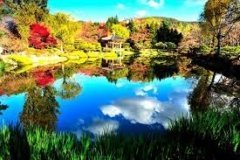
The history of Korea begins with the founding of Joseon (also known as “Gojoseon”, or Old Joseon, to differentiate it with the 14th century dynasty) in 2333 BCE by Dangun, according to Korea’s foundation mythology.[54][55] Gojoseon expanded until it controlled the northern Korean Peninsula and parts of Manchuria. Gija Joseon was purportedly founded in the 12th century BC, but its existence and role have been controversial in the modern era.[55][56] In 108 BCE, the Han dynasty defeated Wiman Joseon and installed four commanderies in the northern Korean peninsula. Three of the commanderies fell or retreated westward within a few decades. As Lelang commandery was destroyed and rebuilt around this time, the place gradually moved toward Liaodong. Thus, its force was diminished and it only served as a trade center until it was conquered by Goguryeo in 313.[57][58][59] Three Kingdoms of Korea During the period known as the Proto–Three Kingdoms of Korea, the states of Buyeo, Okjeo, Dongye and Samhan occupied the whole Korean peninsula and southern Manchuria. From them, Goguryeo, Baekje and Silla emerged to control the peninsula as the Three Kingdoms of Korea. Goguryeo, the largest and most powerful among them, was a highly militaristic state,[60][61] and competed with various Chinese dynasties during its 700 years of history. Goguryeo experienced a golden age under Gwanggaeto the Great and his son Jangsu,[62][63][64][65] who both subdued Baekje and Silla during their times, achieving a brief unification of the Three Kingdoms of Korea and becoming the most dominant power on the Korean Peninsula.[66][67] In addition to contesting for control of the Korean Peninsula, Goguryeo had many military conflicts with various Chinese dynasties,[68] most notably the Goguryeo–Sui War, in which Goguryeo defeated a huge force said to number over a million men.[69][70][71][72][73] Baekje was a great maritime power;[74] its nautical skill, which made it the Phoenicia of East Asia, was instrumental in the dissemination of Buddhism throughout East Asia and continental culture to Japan.[75][76] Baekje was once a great military power on the Korean Peninsula, especially during the time of Geunchogo,[77] but was critically defeated by Gwanggaeto the Great and declined.[78][self-published source] Silla was the smallest and weakest of the three, but it used cunning diplomatic means to make opportunistic pacts and alliances with the more powerful Korean kingdoms, and eventually Tang China, to its great advantage.[79][80] The unification of the Three Kingdoms by Silla in 676 led to the North South States Period, in which much of the Korean Peninsula was controlled by Later Silla, while Balhae controlled the northern parts of Goguryeo. Balhae was founded by a Goguryeo general and formed as a successor state to Goguryeo. During its height, Balhae controlled most of Manchuria and parts of the Russian Far East, and was called the “Prosperous Country in the East”.[81] Later Silla was a golden age of art and culture,[82][83][84][85] as evidenced by the Hwangnyongsa, Seokguram, and Emille Bell. Relationships between Korea and China remained relatively peaceful during this time. Later Silla carried on the maritime prowess of Baekje, which acted like the Phoenicia of medieval East Asia,[86] and during the 8th and 9th centuries dominated the seas of East Asia and the trade between China, Korea and Japan, most notably during the time of Jang Bogo; in addition, Silla people made overseas communities in China on the Shandong Peninsula and the mouth of the Yangtze River.[87][88][89][90] Later Silla was a prosperous and wealthy country,[91] and its metropolitan capital of Gyeongju[92] was the fourth largest city in the world.[93][94][95][96] Buddhism flourished during this time, and many Korean Buddhists gained great fame among Chinese Buddhists[97] and contributed to Chinese Buddhism,[98] including: Woncheuk, Wonhyo, Uisang, Musang,[99][100][101][102] and Kim Gyo-gak, a Silla prince whose influence made Mount Jiuhua one of the Four Sacred Mountains of Chinese Buddhism.[103][104][105][106][107] However, Later Silla weakened under internal strife and the revival of Baekje and Goguryeo, which led to the Later Three Kingdoms period in the late 9th century. Unified Dynasties 936, the Later Three Kingdoms were united by Wang Geon, a descendant of Goguryeo nobility,[108] who established Goryeo as the successor state of Goguryeo.[38][39][40][41] Balhae had fallen to the Khitan Empire in 926, and a decade later the last crown prince of Balhae fled south to Goryeo, where he was warmly welcomed and included into the ruling family by Wang Geon, thus unifying the two successor nations of Goguryeo.[109] Like Silla, Goryeo was a highly cultural state, and invented the metal movable type printing press.[49][50][51][52][53][110][111] After defeating the Khitan Empire, which was the most powerful empire of its time,[112][113] in the Goryeo–Khitan War, Goryeo experienced a golden age that lasted a century, during which the Tripitaka Koreana was completed and there were great developments in printing and publishing, promoting learning and dispersing knowledge on philosophy, literature, religion, and science; by 1100, there were 12 universities that produced famous scholars and scientists.[114][115] However, the Mongol invasions in the 13th century greatly weakened the kingdom. Goryeo was never conquered by the Mongols, but exhausted after three decades of fighting, the Korean court sent its crown prince to the Yuan capital to swear allegiance to Kublai Khan, who accepted, and married one of his daughters to the Korean crown prince.[116] Henceforth, Goryeo continued to rule Korea, though as a tributary ally to the Mongols for the next 86 years. During this period, the two nations became intertwined as all subsequent Korean kings married Mongol princesses,[116] and the last empress of the Yuan dynasty was a Korean princess. In the mid-14th century, Goryeo drove out the Mongols to regain its northern territories, briefly conquered Liaoyang, and defeated invasions by the Red Turbans. However, in 1392, General Yi Seong-gye, who had been ordered to attack China, turned his army around and staged a coup. Yi Seong-gye declared the new name of Korea as “Joseon” in reference to Gojoseon, and moved the capital to Hanseong (one of the old names of Seoul).[117] The first 200 years of the Joseon dynasty were marked by peace, and saw great advancements in science[118][119] and education,[120] as well as the creation of Hangul by Sejong the Great to promote literacy among the common people.[121] The prevailing ideology of the time was Neo-Confucianism, which was epitomized by the seonbi class: nobles who passed up positions of wealth and power to lead lives of study and integrity. Between 1592 and 1598, Toyotomi Hideyoshi launched invasions of Korea, but his advance was halted by Korean forces (most notably the Joseon Navy led by Admiral Yi Sun-sin and his renowned “turtle ship”)[122][123][124][125][126] with assistance from Righteous Army militias formed by Korean civilians, and Ming dynasty Chinese troops. Through a series of successful battles of attrition, the Japanese forces were eventually forced to withdraw, and relations between all parties became normalized. However, the Manchus took advantage of Joseon’s war-weakened state and invaded in 1627 and 1637, and then went on to conquer the destabilized Ming dynasty. After normalizing relations with the new Qing dynasty, Joseon experienced a nearly 200-year period of peace. Kings Yeongjo and Jeongjo particularly led a new renaissance of the Joseon dynasty during the 18th century.[127][128] In the 19th century, the royal in-law families gained control of the government, leading to mass corruption and weakening of the state, and severe poverty and peasant rebellions throughout the country. Furthermore, the Joseon government adopted a strict isolationist policy, earning the nickname “the hermit kingdom”, but ultimately failed to protect itself against imperialism and was forced to open its borders. After the First Sino-Japanese War and the Russo-Japanese War, Korea was occupied by Japan (1910–45). At the end of World War II, the Japanese surrendered to Soviet and U.S. forces who occupied the northern and southern halves of Korea, respectively. http://bit.ly/2IoEQrx
2 notes
·
View notes